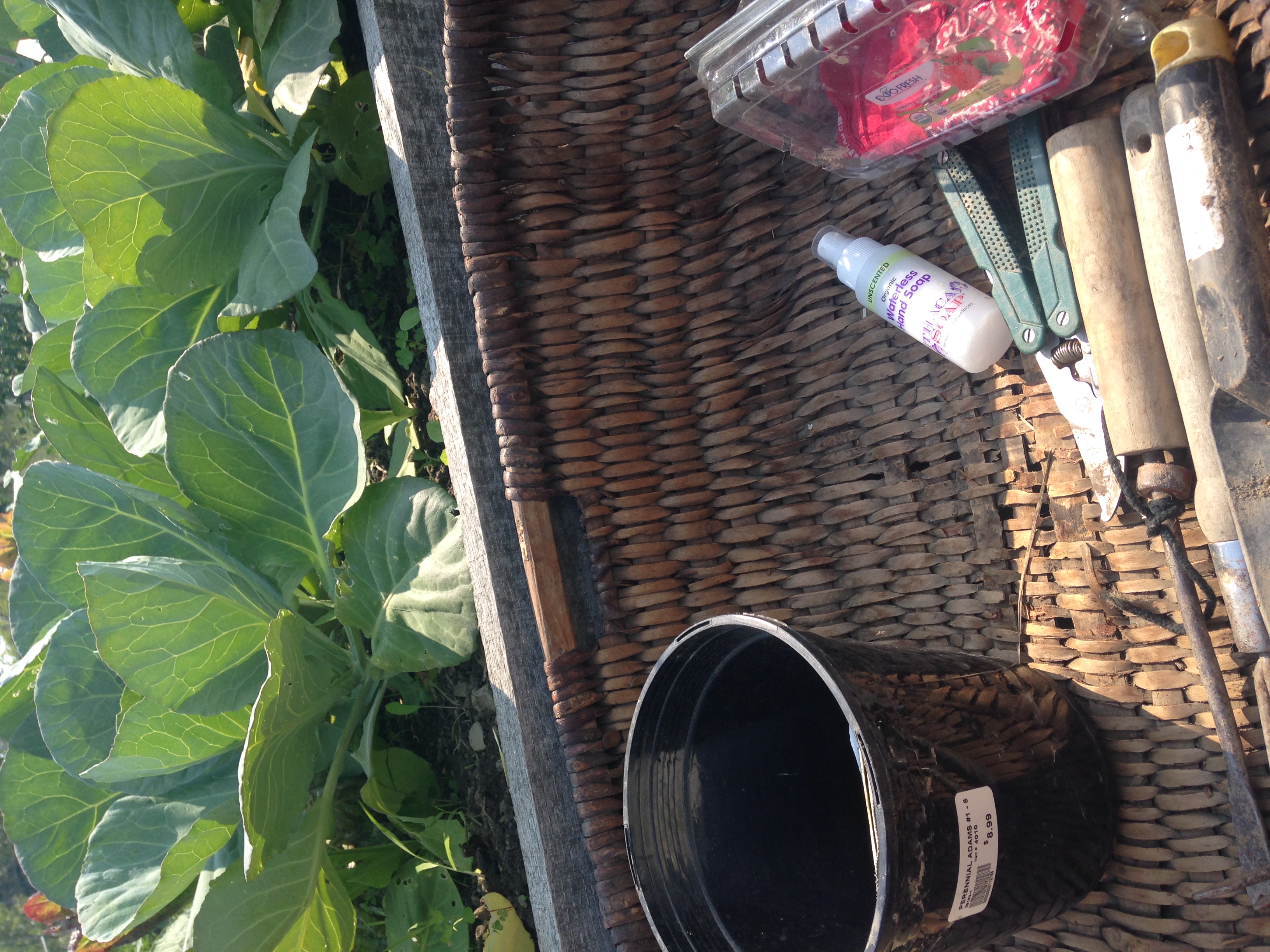It's time to get the comfort you deserve. Good soap matters. soapisbest.com
- Home
- Liquid Hand Soap Refill
- Garden
Garden
A garden is a Zen place for me. It's peaceful, gratifying, and rewarding. Fitting all of the tiny seedlings in, while remembering to leave enough room for them to grow to their full potential, and maximizing harvest abundance, is a creative challenge. Learning about plants, what they need and how they grow is a secret world that feeds us spiritually while we watch the plants grow, and physically when we plan what to do with the harvest.
Click here for recipes
Planting organic vegetables is so good for you in many ways. You become connected to your food source.
Having a heavy duty hand soap, that's gentle on your garden hands is an essential in your garden basket.
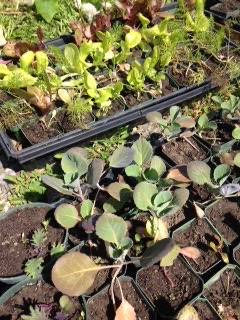 my seedlings are ready to go in the ground
my seedlings are ready to go in the groundStarting garden seeds at home
Starting garden seeds at home is fun and rewarding. Every year I perfect my method, making adjustments to increase my success rates. I usually have one round of succession plants, meaning I'll plant a second batch of seeds after I move the 1st batch outside to harden off, so they are strong enough to withstand wind and rain. That could include 80 more plants. The 2nd round of seeds could be started in the greenhouse.
When you purchase a packet of seeds, read the packet for planting instructions. They are pretty basic. Some seed companies have fantastic websites, loaded with botanical information, to help you have the best garden possible. There's so much to know, from companion planting and different soil types for different plants. A seed selling company wants you to have as much information as possible so your garden is a great success.
Fall garden
Everything in the brassica family grows better in the cooler temperatures. July is a great time to get started.
Plant broccoli, cabbage, kale, cauliflower, turnip, kohlrabi, Brussel sprout, lettuce, escarole, endive, collards seeds in the greenhouse or somewhere outside in a protected area in starter seedling trays.
In the few weeks that the seeds need to germinate and grow a bit, you can get your fall garden beds ready to be planted, starting in early August. I like to do 2-3 plantings 2-3 weeks apart.
Wake the beds up by fluffing up the soil, remove weeks, add compost and mulch, so the beds are ready to feed those baby brassica plants. You'll be harvesting late September through December, especially with floating row covers.
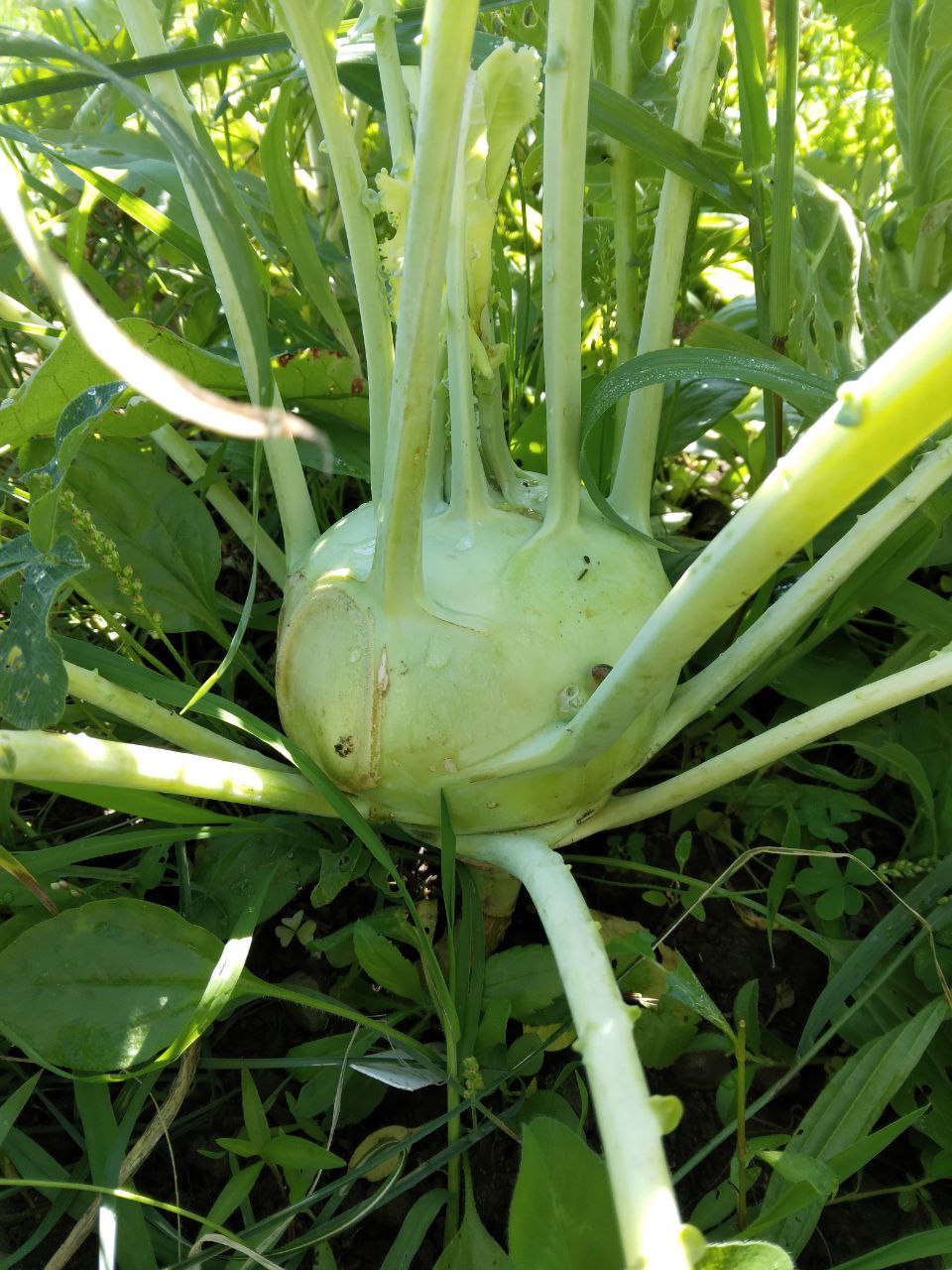 Gigante Kohlrabi Gigante Kohlrabi |
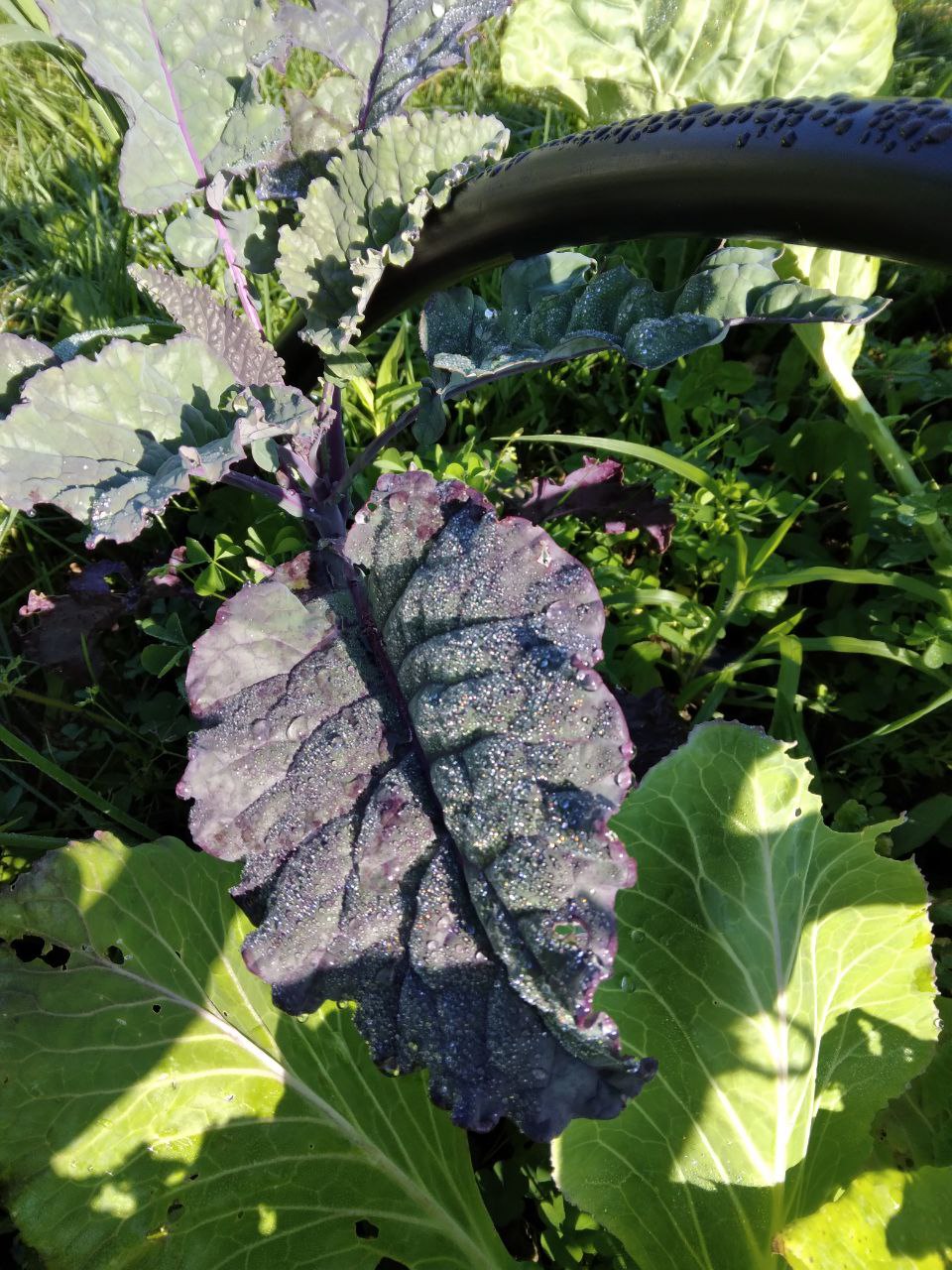 Lacotino Kale with morning dew Lacotino Kale with morning dew |
soap for aphid eradication
I start my seeds in my sunniest windows every year. in 2023, we had a temperate Winter. I thought I had some fruit flies from my apple cider vinegar making adventures. I didn't understand why my fruit fly traps were not catching them.
One evening, at sunset, I noticed those fruit changed and my tiny, beautifully growing seedlings were covered in tiny transparent dots. They were very small, so I needed the magnifying glass to see them. These dots had eyes and legs. At 1st glance I panicked, thinking they were tics! We would be dead in a few hours from thousands of tics!
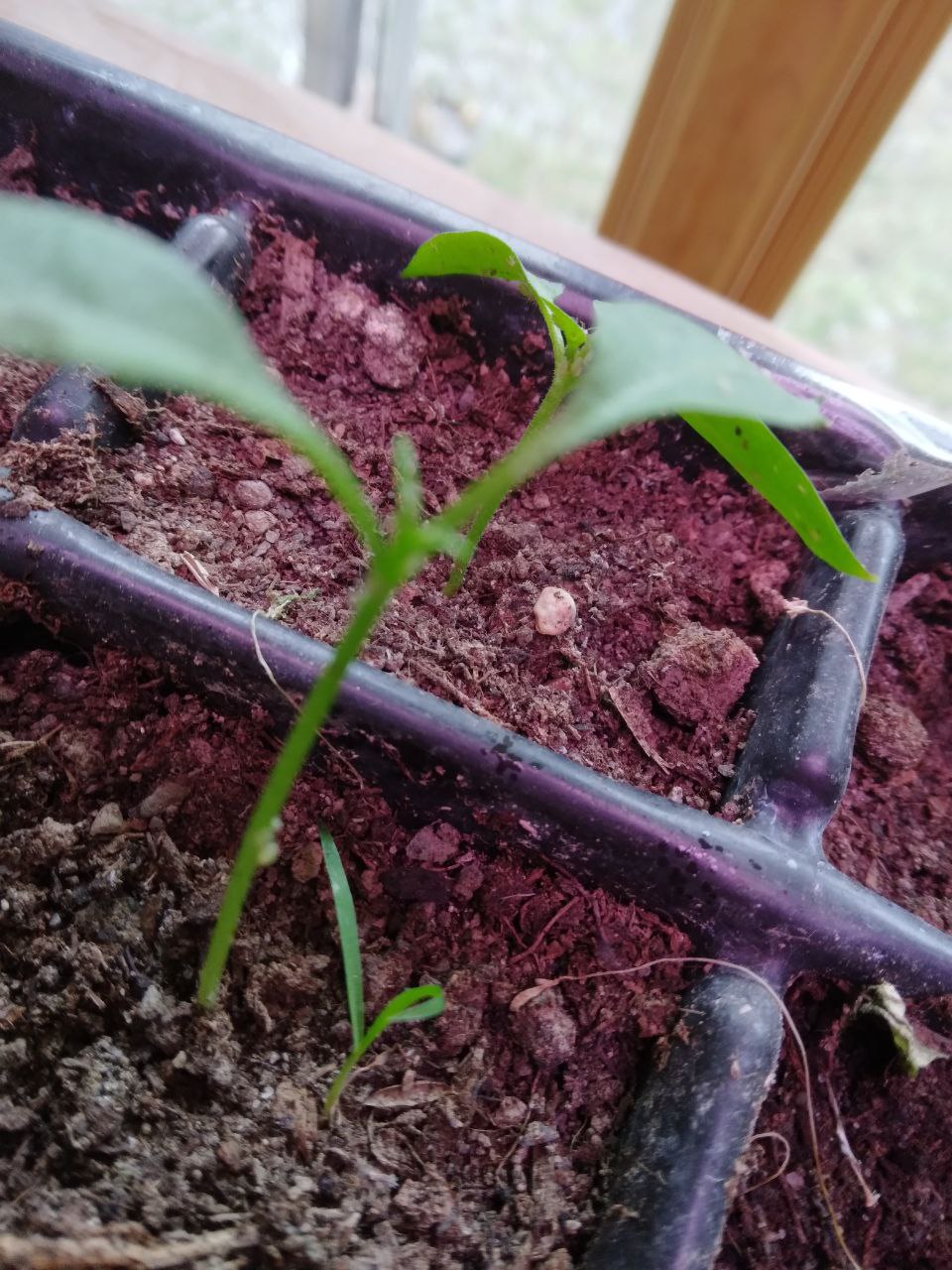 Pepper seedling with aphid nymph. The tiny yellowish dot on the stem is the nymph Pepper seedling with aphid nymph. The tiny yellowish dot on the stem is the nymph |
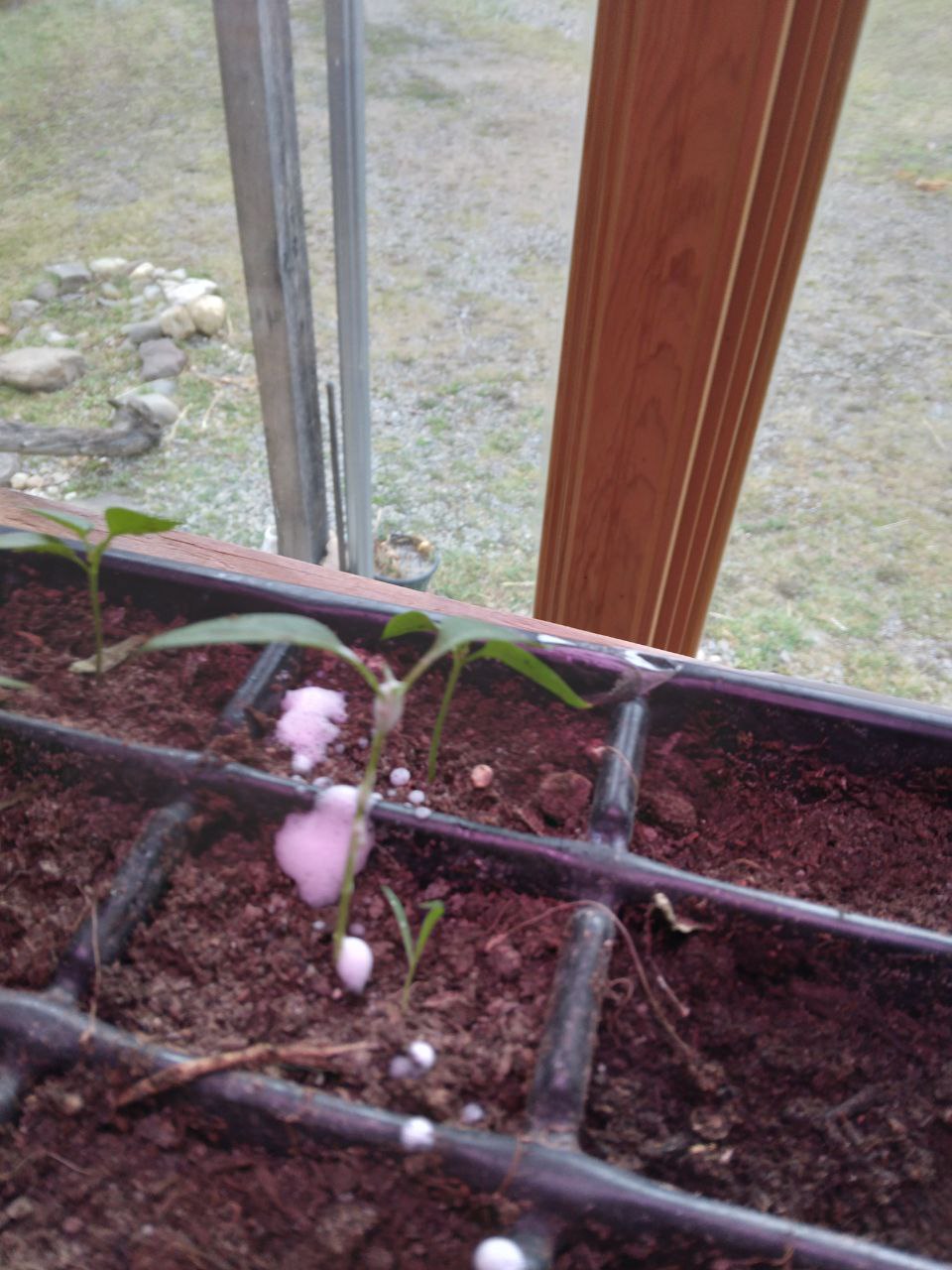 Unscented Instant Liquid Soap diluted to Go Soap ration(1 bag in 2 gallons water), sprayed on the pepper plant. Unscented Instant Liquid Soap diluted to Go Soap ration(1 bag in 2 gallons water), sprayed on the pepper plant. |
As I calmed myself down and took control of my thoughts, I realized they could be aphids and did am internet search to see the life cycle of aphids. I didn't know they had a tiny fly stage that changed into the nymphs that were just about to grew into their next stage and eat my garden.
I acted quickly and got my handy spray bottle filled with Instant Liquid Soap diluted to the Go Soap ratio, below.
I sprayed my seedlings and the dirt surface with the soap solution, thinking they would either live or die. I didn't spray enough soap on the dirt to "water the plants". I sprayed just enough to get the aphids on the top of the soil.
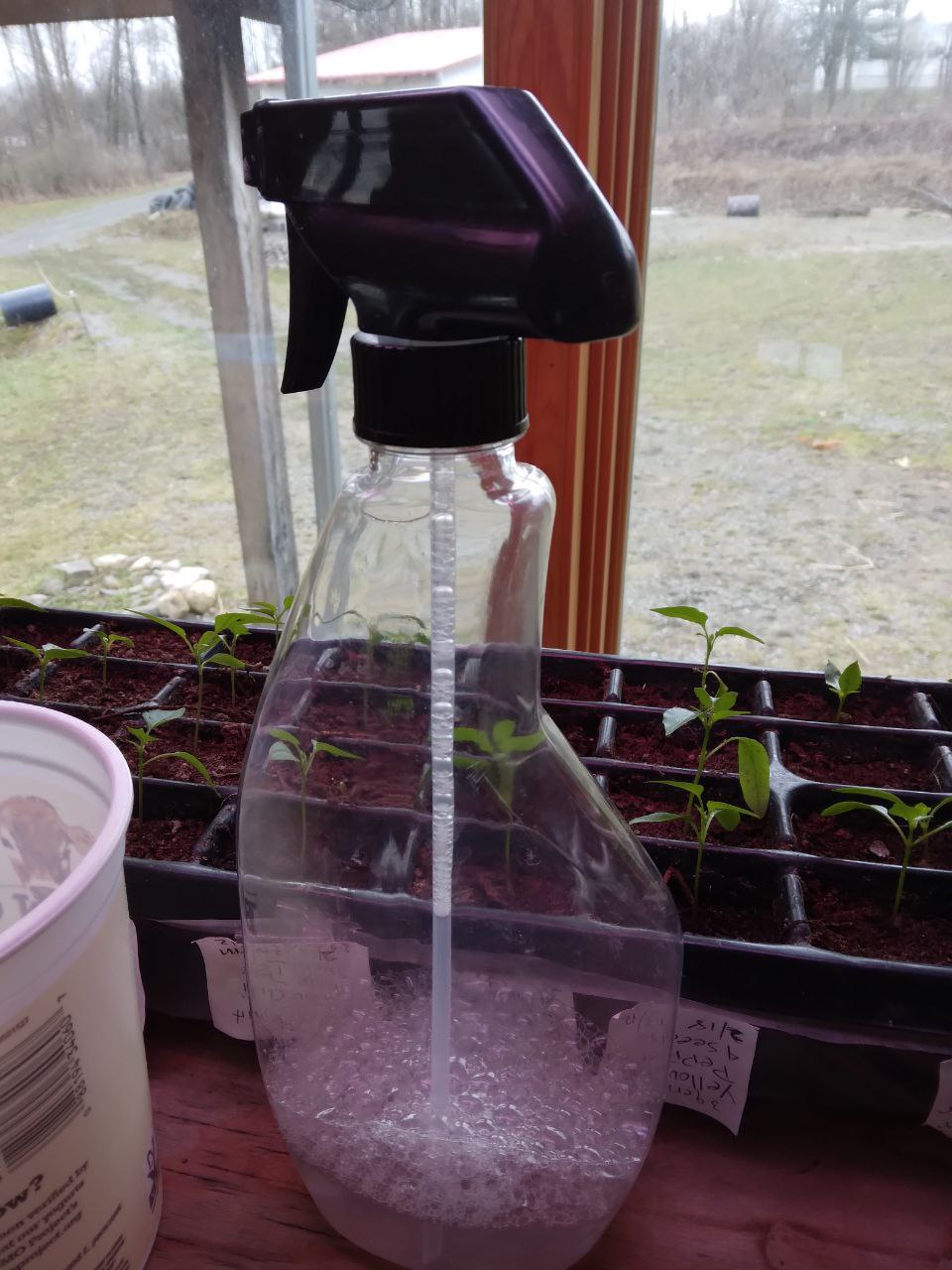 Go Soap in spray bottle Go Soap in spray bottle |
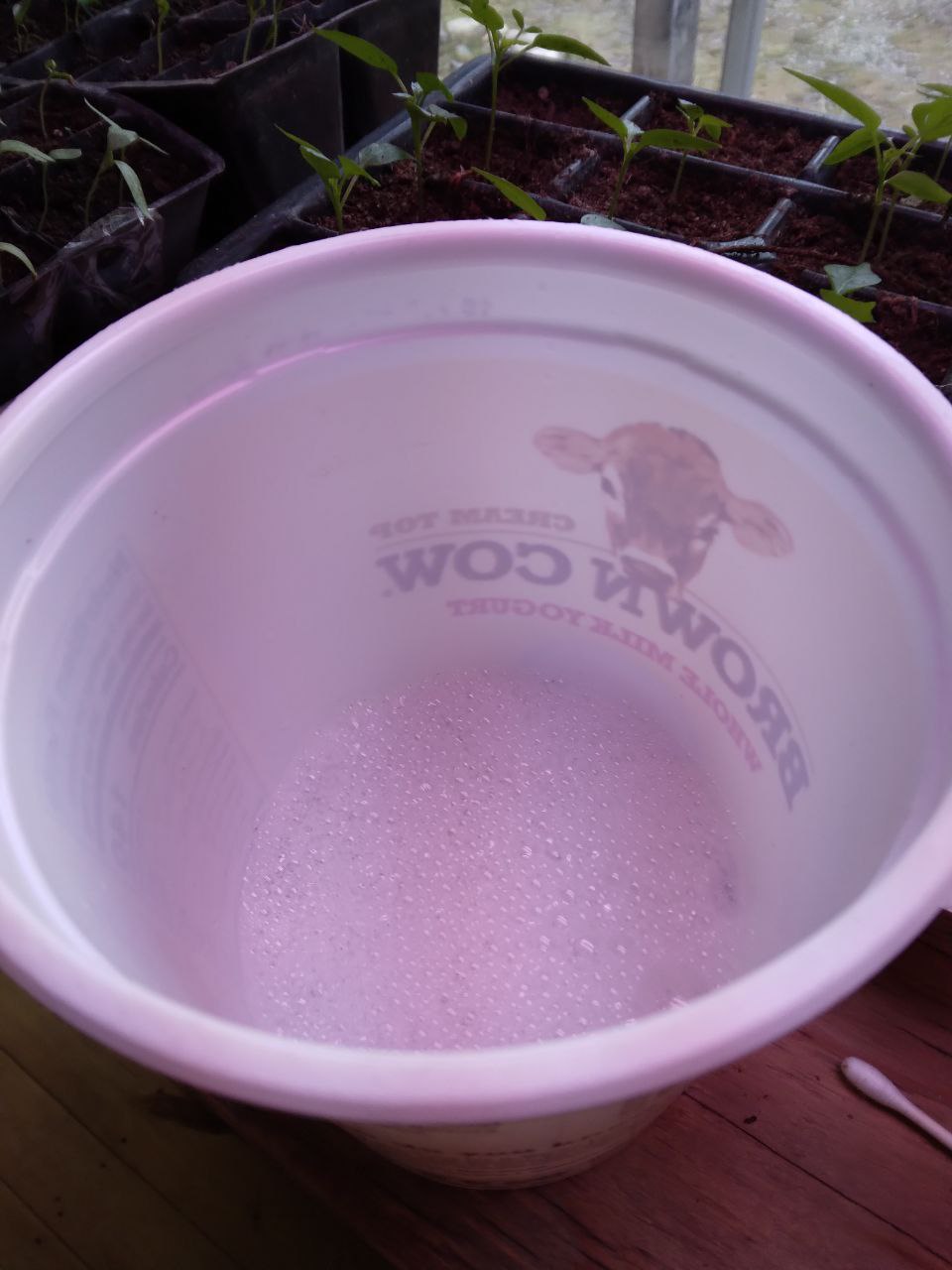 Go Soap in yogurt container. Go Soap in yogurt container. |
Then I put a couple of inches of this soap solution into a plastic quart yogurt container and got a cotton swab. I dipped the swab in the soap and carefully wiped down every leaf and stem, including the brand new tiny leaves in the growing center heart, collecting these aphid nymphs and either squishing them by collecting them or drowning them in the soap in the yogurt container. I didn't do all of the plants, to see if simply spraying them would be enough.
I didn't water the seedlings that evening so they wouldn't "drink" the soap. Then the next morning, I got out my magnifying glass to examine the seedlings. Some of the nymphs were dead, and some seemed to be stunned. I repeated the swabbing task, this time getting every plant. Miraculously, my seedlings did not die, but perked up! I thought they were good before, but they were better. The soap made it simple to clean off the aphids, without harming my seedlings at all.
I waited til the soil was dry, before I watered, in a day or so. It all worked beautifully.
I repeated the process again 2 days later as insurance.
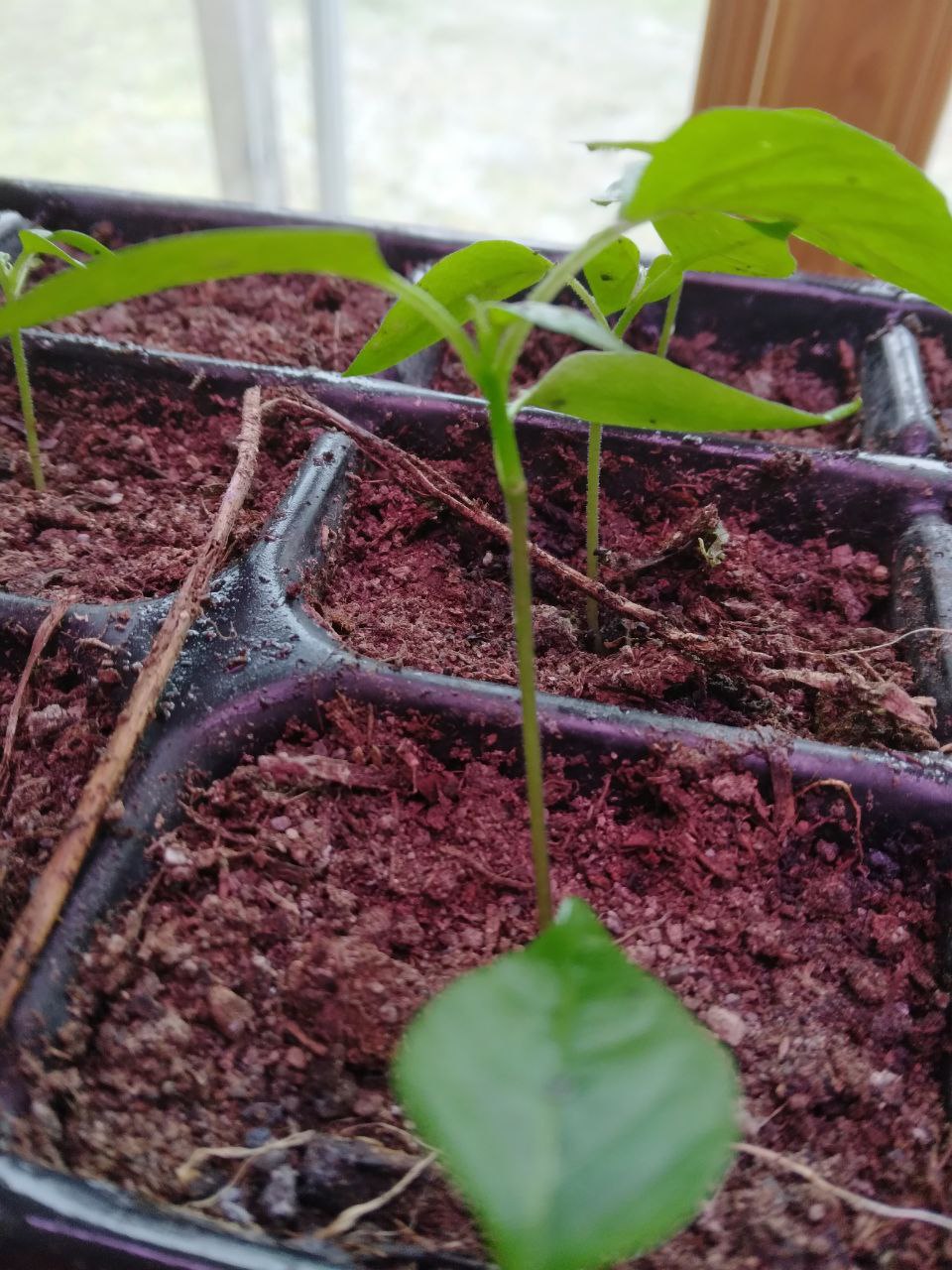 Pepper plant after aphid nymph washed off Pepper plant after aphid nymph washed off |
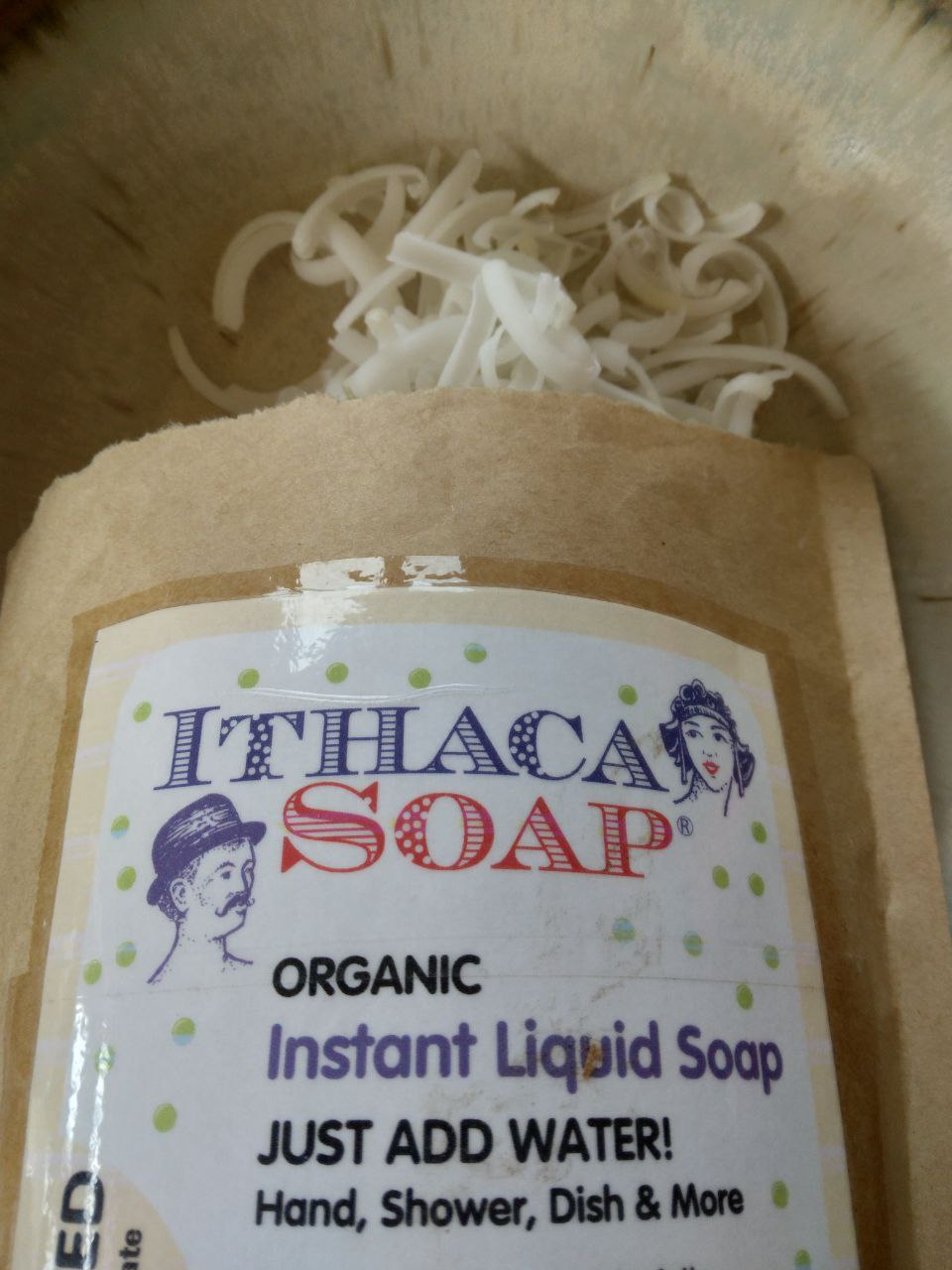 Instant Liquid Soap is so versatile. Instant Liquid Soap is so versatile. |
Go Soap (aka Waterless Hand Soap) dilute ratio
We have renamed Waterless Hand Soap to Go Soap.
You have an empty Waterless Hand Soap 2 oz. spray bottle and want to refill it. Make a Go Soap refill.
Dilute one bag of Instant Liquid Soap into one quart of liquid soap (32 oz.).
Follow the instructions on the package.
Pour 1/2 of the quart of liquid hand soap (16 oz.) into a one gallon container and fill it SLOWLY with water. This makes 1 gallon of Go Soap, aka waterless hand soap, that you use as hand sanitizer replacement and general cleaner.
Refill an empty spray bottle to use on everything. Click here for more uses
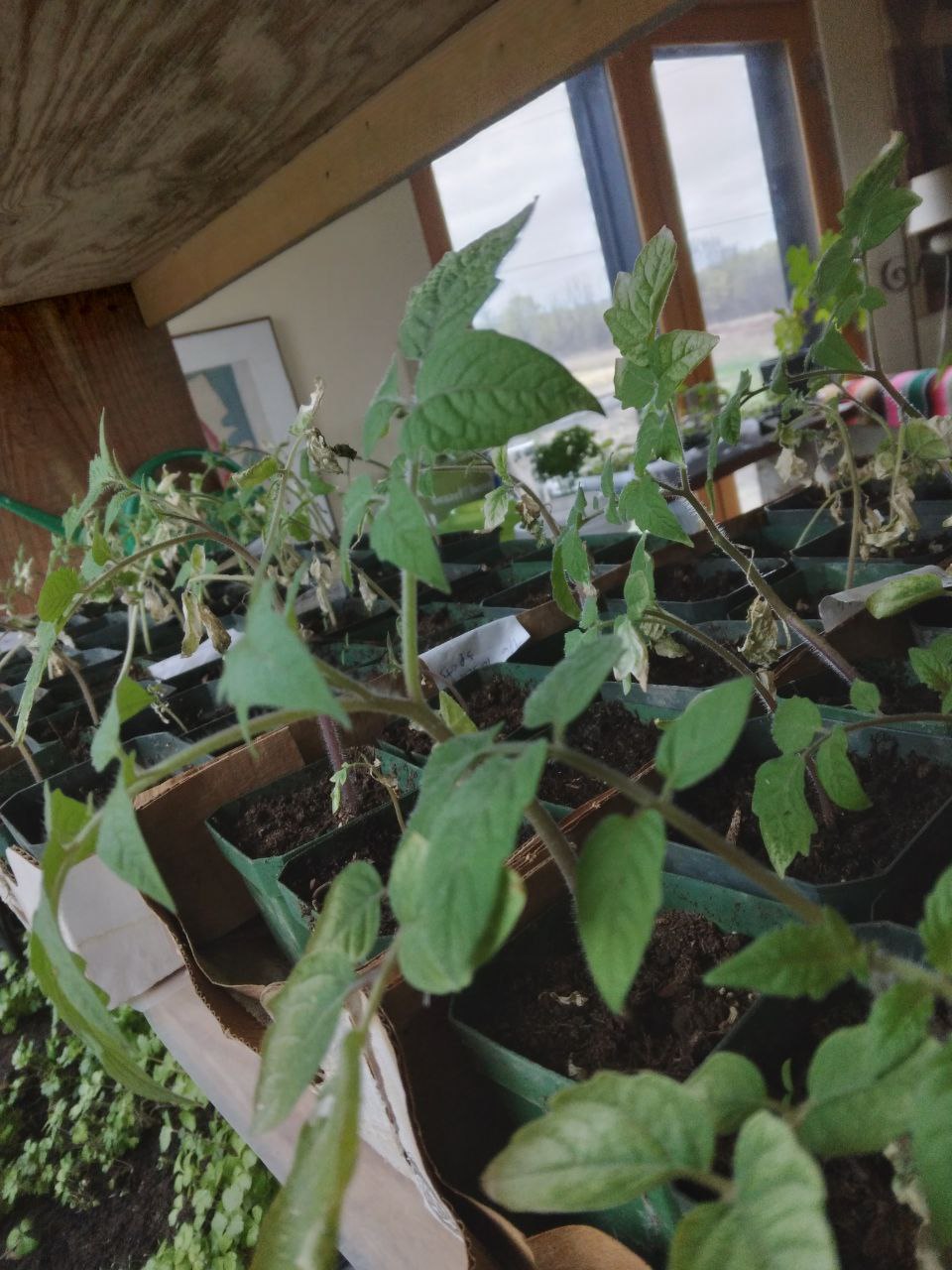
It's been 4 weeks since my aphid scare. We had a bit of a heat wave in mid-April and I began the hardening off process, by putting my seedlings outside during the warm days. My seedlings grew inches and have remained aphid free.
I am reading a fabulous gardening book, which advised me to water seedlings throughout the days when they are hardening off. Wind and more sun is a new thing for the tiny delicate plants, which will dry out the small amount of soil in their seedling pots. The book is called "Gardening Wisdom and Know-How" from the editors of Rodale Press. You will likely have to find a used copy.
Keeping clean while getting dirty
Keeping clean while getting dirty in the garden can be a challenge. Especially when you side dress your growing plants with compost. Side dressing means to put compost around the plants, but not necessarily touching the plants.
The best time to do this is right before it's going to rain during, hot times in your growing season. This way, the compost gets washed into the soil and feeds your plants quickly, before the heat and steamy air sets in after the rain. Your plants will grow and be very happy during this feeding.
Gardening cleaning tricks save you time, while keeping you comfortable. Have a hose, some Instant Liquid Soap, and a sponge ready to clean up after side dressing with compost.
Since it's hot when it's side dressing time, I wear my rubber hiking sandals without socks while doing this messy task. Inevitably I will get mud and compost in my sandals and all over the outside of them. As soon as the plants have been fed, I remove my sandals, hose them off, and then soap them up inside and out. I use the sponge to scrub the tread to get all of the compost out from in-between the tread. Rinse and place the now clean garden shoes in the sun to dry, while I take a quick shower to get the compost off of my arms and legs.
Ithaca Bar Soaps are a cold process bar soap formulation, that remains solid throughout its use. For a longer life, keep in a dry place between washings. If a bar of soap sits in a puddle, it will shorten its lifespan, but will not turn to a liquid. If you attempt to melt Ithaca Soap Bars, they will re-harden eventually.
Ithaca Soap's Instant Liquid Soap is a completely different formulation. This patented soap formulation is not meant to be used as bar soap. Its solid appearance will immediately begin to turn into liquid soap, when it comes in contact with water, diluting it into our same Ithaca Soap Liquid Soap.
Melons
I learned by accident that melons like NO breeze, what so ever. The best melons I have ever grown, were the vines that spread through a bunch of garden debris stacked up behind one of the garden beds. It occurred to me that those melons were so sweet and large, because the air didn't move very much in that location.
Now, I will leave the floating row cover around the melon beds, even after I uncover them to let the bees pollenate the flowers. Some of the beds I only uncover to let the bees in and to dry out the plants. It's a fine line between no breeze and no mould on the plants.
Organic potting soil and compost
What is compost? Compost is decomposed food scraps, livestock poop (cow, chicken, pig, sheep, goat, horse), straw, grass clippings, etc, that have decomposed to make nutritious soil to feed your garden.
I have found that organic potting soil is very helpful in your seed starting success. If you have a good soil mix in your garden, that might make good seed starting soil. You will have to do experiments. I have a nice soil mix of my garden soil, chicken poop compost, food scrap compost, and sand. That's half of my potting soil. The other half is peat moss. It is a light airy mix.
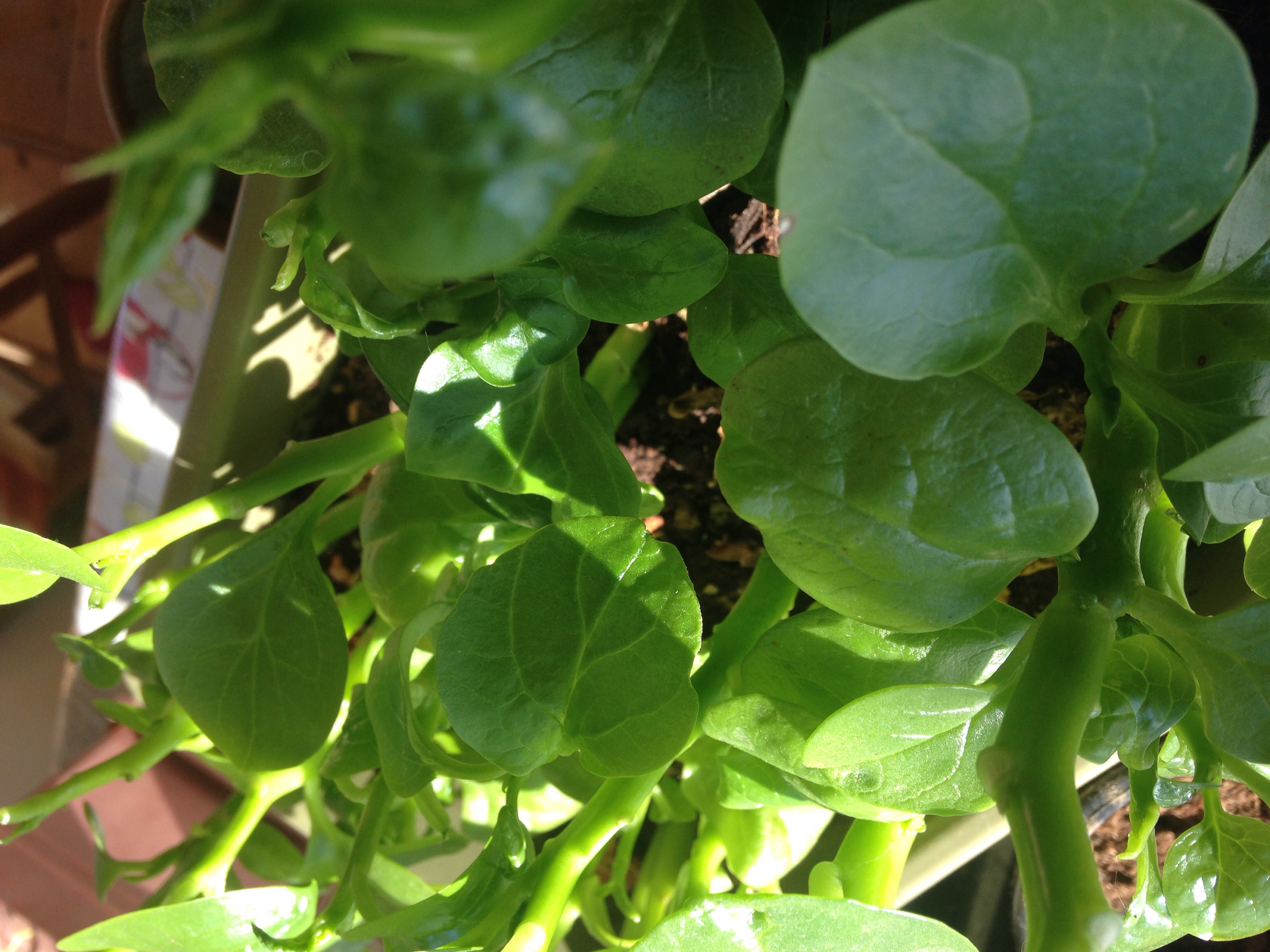 Potted Asian spinach.
Potted Asian spinach.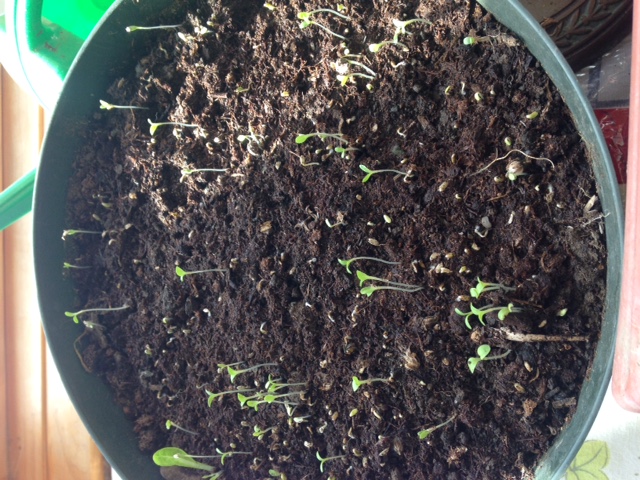 Lettuce micro greens from my saved seeds
Lettuce micro greens from my saved seeds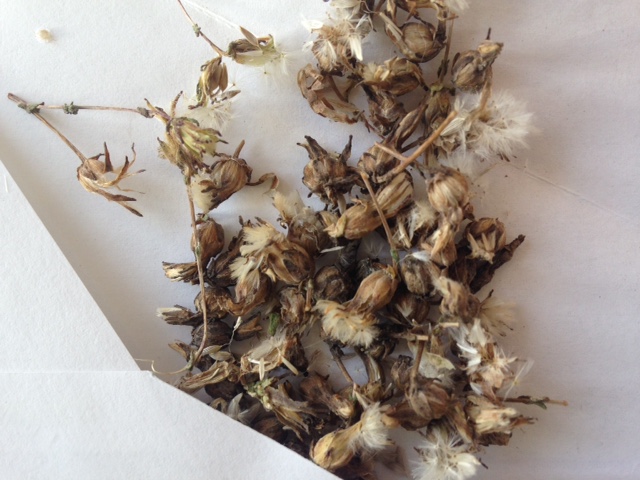 My saved lettuce seeds
My saved lettuce seedsThe photo to the right above are my saved lettuce seeds in their dried flower heads. The white wispy part are the dried flower petals. Below the petals is a brown bulb. The seeds are in there. Since the flower heads are fragile, I simply crush them between my fingers and sprinkle them on top of my potting soil mix. You can see the seeds in the center photo above. They are the white specs.
Tomato pruning and hand washing
I prune my tomatoes for maximum production. Thinning the leaves and not so useful branches keeps the plants from getting moldy underneath. This way you can use the upper branches as shade for lettuces. Companion planting lettuce will soak up any extra water during heavy rains. It's a win win.
When pruning and staking tomatoes, I do not wear gloves, since it is delicate work and I do not want to damage plants with clumsy gloves. But this will get your hands covered in green tomato plant dust. This dust is a protective coating on the plants, that is moldy toxic to us and can be deadly to chickens.
By mildly toxic to humans, I mean if you get too much of it on you, you can get headaches, or it can activate arthritis. When I do this work, I limit myself to pruning a few plants, and take a hand washing break to wash off the green dust. This can lead to a lot of hand a maybe face washing's if you brushed away a mosquito and got some green dust on your face. Using gentle soap is imperative to avoid irritation, when washing so many times, especially if you have a lot of tomato plants..
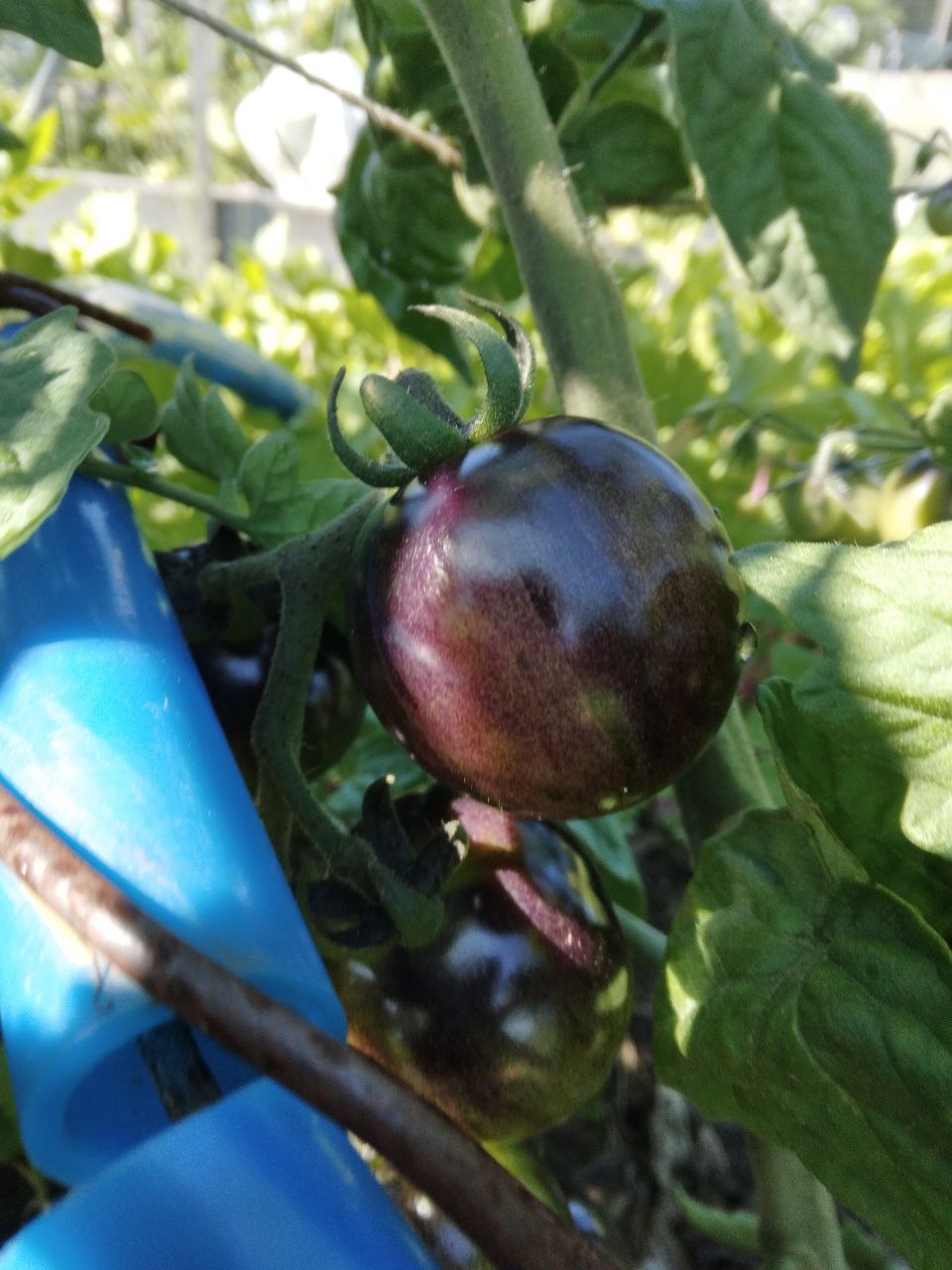 Black strawberry tomato Black strawberry tomato |
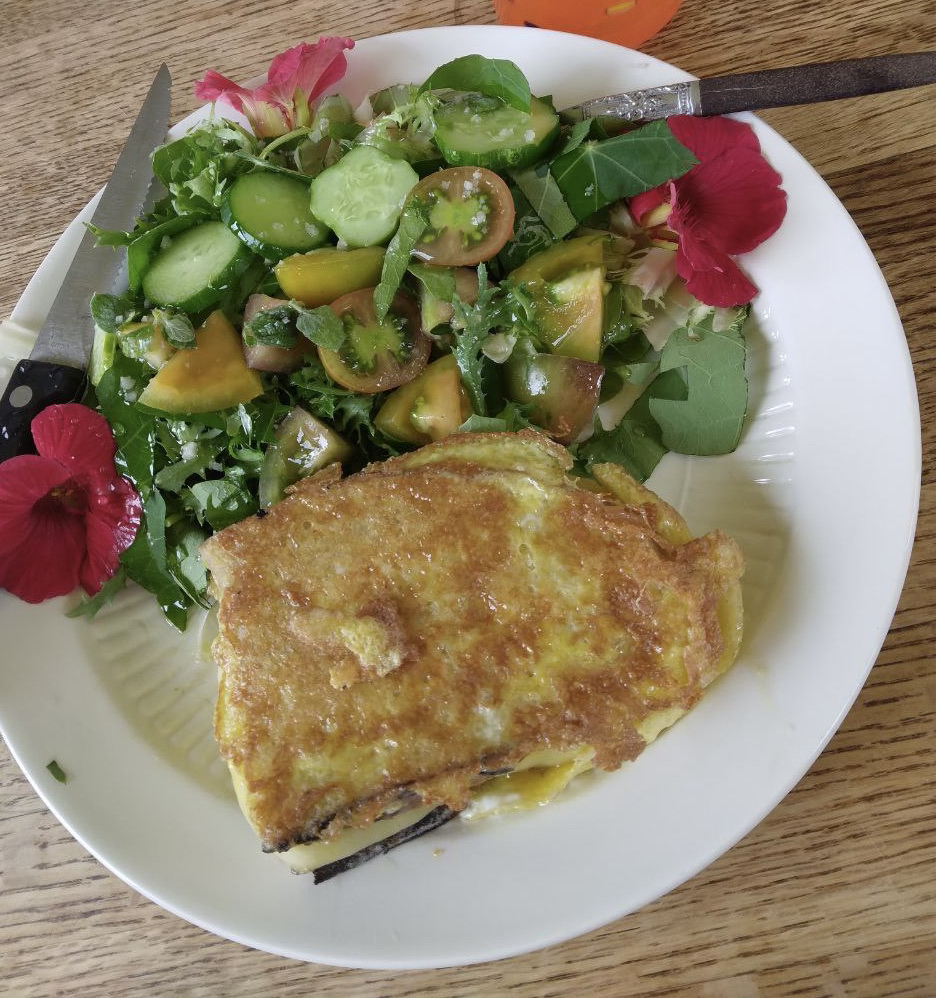 4 different colored tomatoes in this salad 4 different colored tomatoes in this salad |
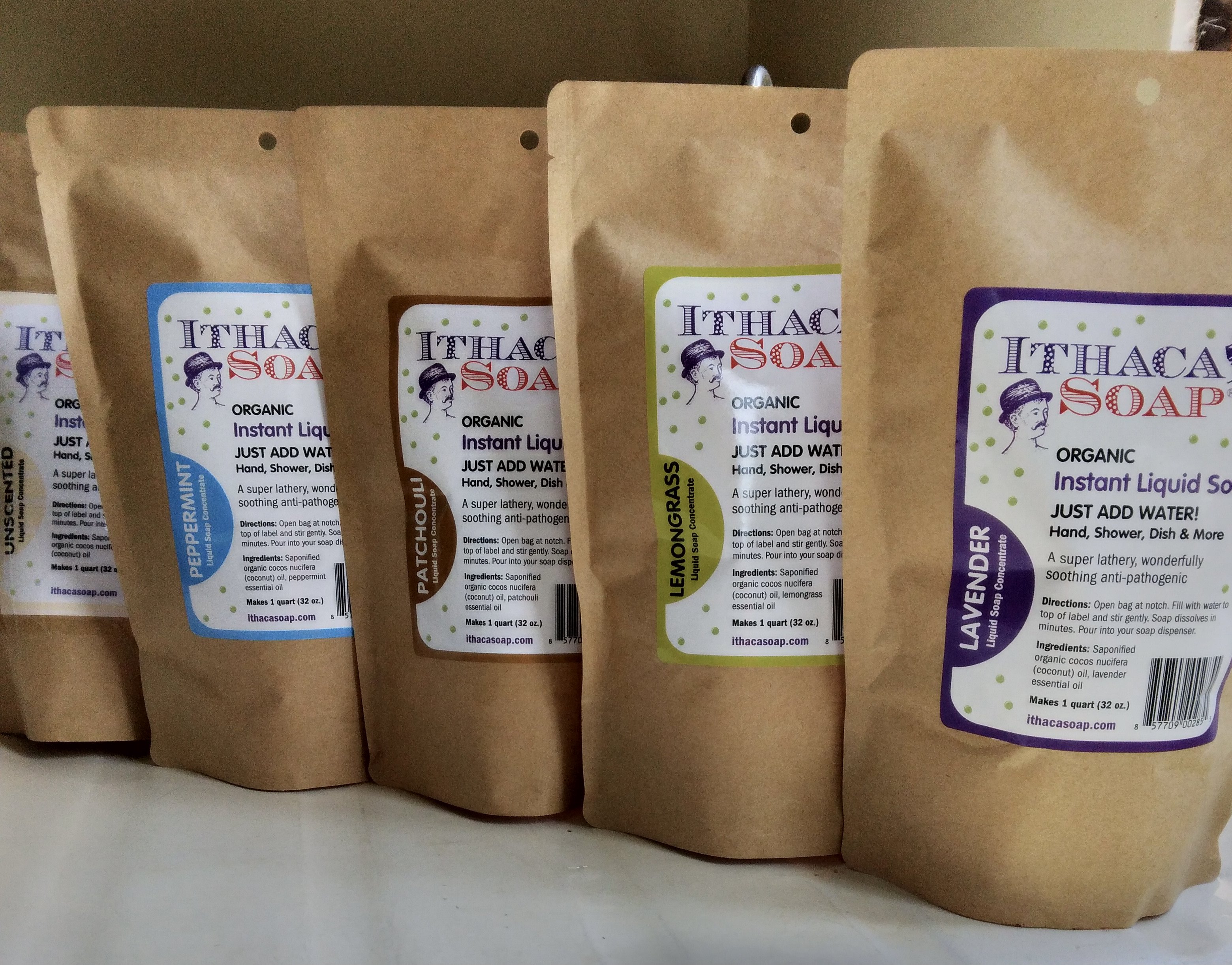 Choose from 5 different natural essential oil scents
Choose from 5 different natural essential oil scentsInstant Liquid Soap is the perfect stovetop cleaner. It's gentle on your hands while being tough on built up, caked on grease. Click here to read How to Clean your Greasy Stovetop using zero waste natural soap methods
- Tear open pouch at notch
- Fill pouch with water to top of label. Gently stir.
- Pour into a reused plastic bottle. Use.
The future starts now as you end single use plastic bottles. Click here
Watering tips
I have a few different watering techniques, depending on where we are in the gardening cycle.
In the early Spring, I don't water much, since the ground is still wet from the snow melt. When I do water, it can be at any time of day. If it's going to freeze at night, I try to avoid water too much and also avoid getting more delicate leave, like lettuce, wet to avoid frost issues.
In the hot part of late Spring to early Summer, I try to water in the late evening around dusk. This way the plants can drink during the night and grow during the hot steamy day. I will water seeds every day until they germinate, and even water over top of the plants, so the water will sit on leaves, forming little drinking fountains for helpful insects.
In the hottest part of the Summer, I will water in the early morning. I do my best to only water the bottom of the plants, between the bottom leaves and the soil. This will cut down on leave sunburn.
A note on watering tomatoes: If possible, never water the leaves, and only water the base of the stem by the soil, leaving the poisonous green dust in tact to ward off insects.
A note on watering cucumbers, zucchinis, squashes, and melons: I like to try to avoid watering the leaves, when the plants are established to try my best to keep powdery mildew at bay. It is airborne, sop if the leaves are dry during the days, while the mildew is floating by, this cuts down on the possibility of it sticking.
Lettuce and spinach: as much as possible, try to avoid getting the bottom, outer lettuce leaves too wet with mud splatter. The mud splatter will rot the leaves and create brown spots, as it begins to compost.
As the garden cycle moves into late Summer and the days are cooler, I'll go back to evening watering. Also cut back on the amount of water to avoid tomato splits and soggy melon rinds, and soft spots on pumpkins.
In the early Fall, I cut back to watering only when the plants look thirsty. Maybe every few days to once a week. The morning dew will also be much heavier to do the watering for you. Your plants will be big, shading the ground and keep it from drying up quickly.
shop Ithaca Soap and Beeswax Lip Balm
Seed saving
Seed saving completes the food growing cycle. Some seeds, like tomatoes and peppers are very easy to collect and save, while others require you to keep the plant alive into its 2nd year. Some plants will cross pollenate, yielding lovely food, but seeds not worth planting. Some cross pollenated seeds will yield new varieties. It's a lot to learn if you're a self taught botanist, otherwise know as a gardener.
An easy way to save seeds is to plant only 1 variety of a particular plant. That method makes for a simple garden, especially if you prefer to grow a variety of squashes for example. I saved 2 different kinds of lettuce seeds. I let a few plants flower and go to seed at different times, in an effort to avoid cross pollination. I then planted my 2 lettuce types of saved seeds for micro greens in the indoor Winter garden to see if they in fact did not cross pollenate. If they did I will purchase new seeds for the following year's garden. If they did not cross pollenate, I will add to my lettuce varieties and again let some plants flower and go to seed at different times.
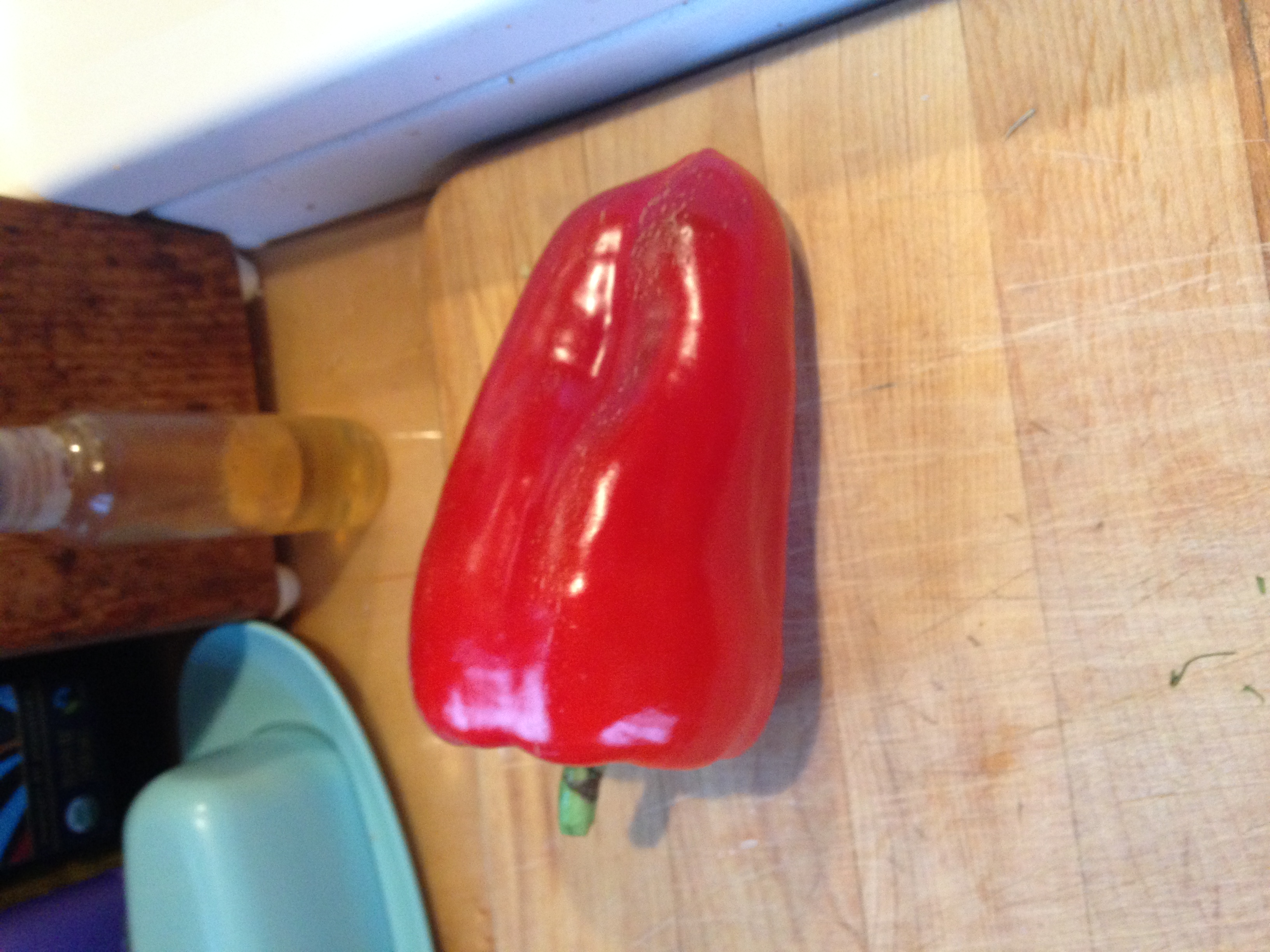
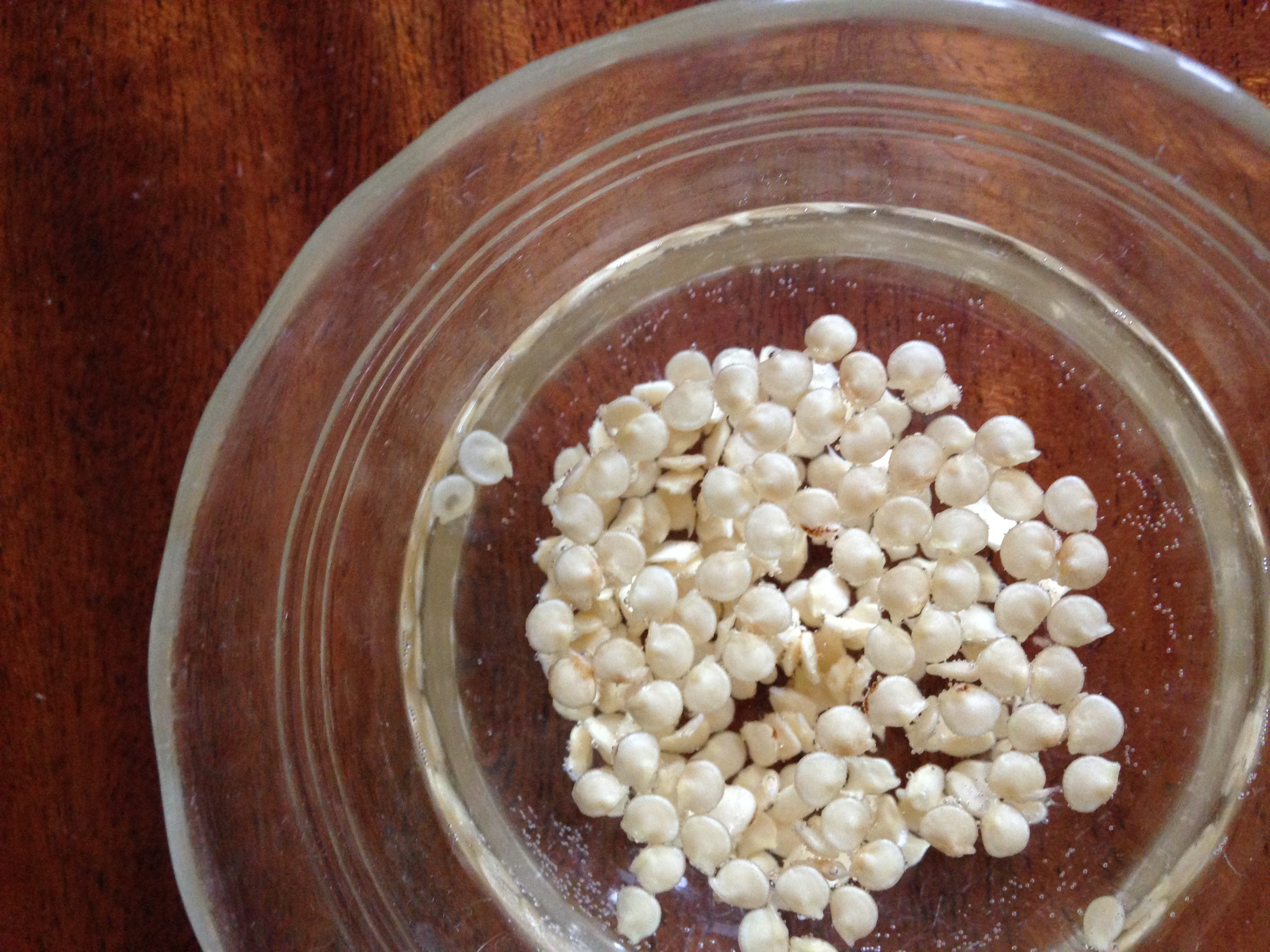
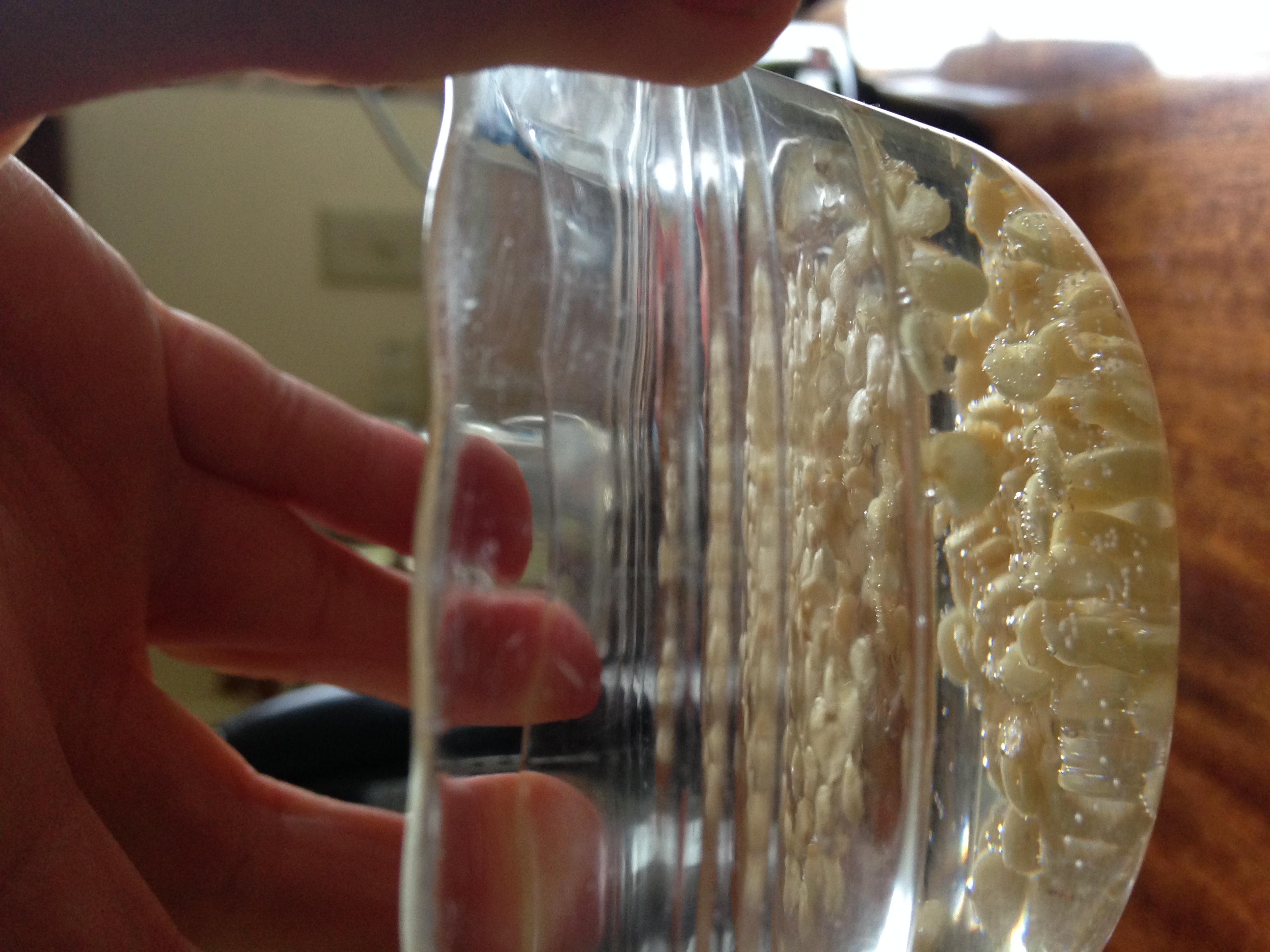
The delicate and gentle seed saving task is fun and fruitful. I find it gives me a great sense of security somehow being connected to something so available and abundant.
Pictured above is a beautiful organic sweet red bell pepper. It is totally ripe when it's color is full and rich. Slice it open and carefully remove the seeds. Place them in a small cup and fill it with drinking water.
Wait 30 minutes. The mature seeds will sink, while the immature seeds float. Pour off the water, along with the immature seeds. Place the mature seeds on a paper towel or smooth cloth napkin. Spread them out and fold the napkin, so the seeds are covered and protected from fruit flies and dust. Wait a few days for them to dry thoroughly. Place the seeds in an envelope, labeled with the seed type and year. Store in a dark dry place until the next planting cycle.
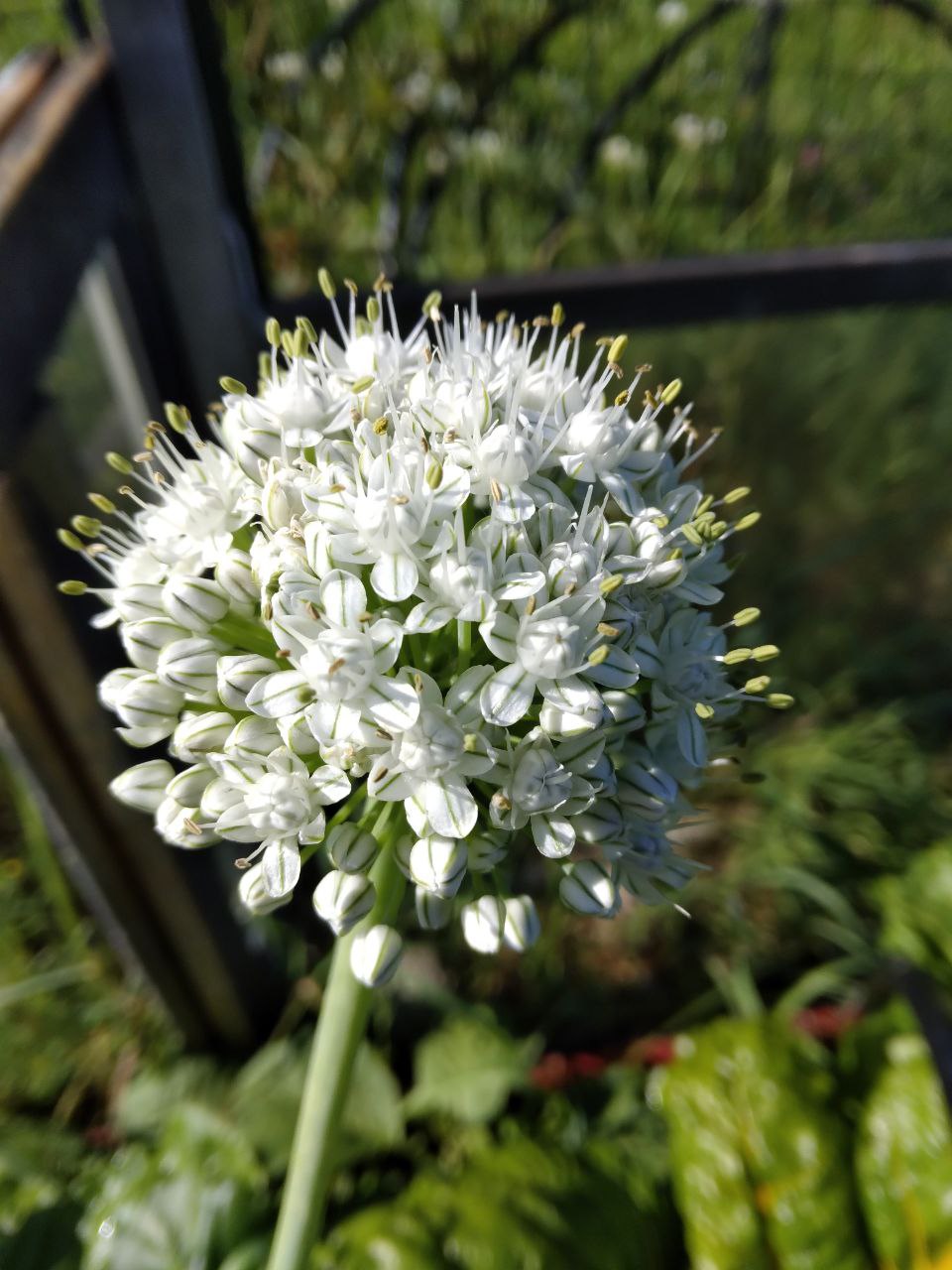 This is Rosa di Milan red cooking onion seed flower. Each florette contains 3 seeds This is Rosa di Milan red cooking onion seed flower. Each florette contains 3 seeds |
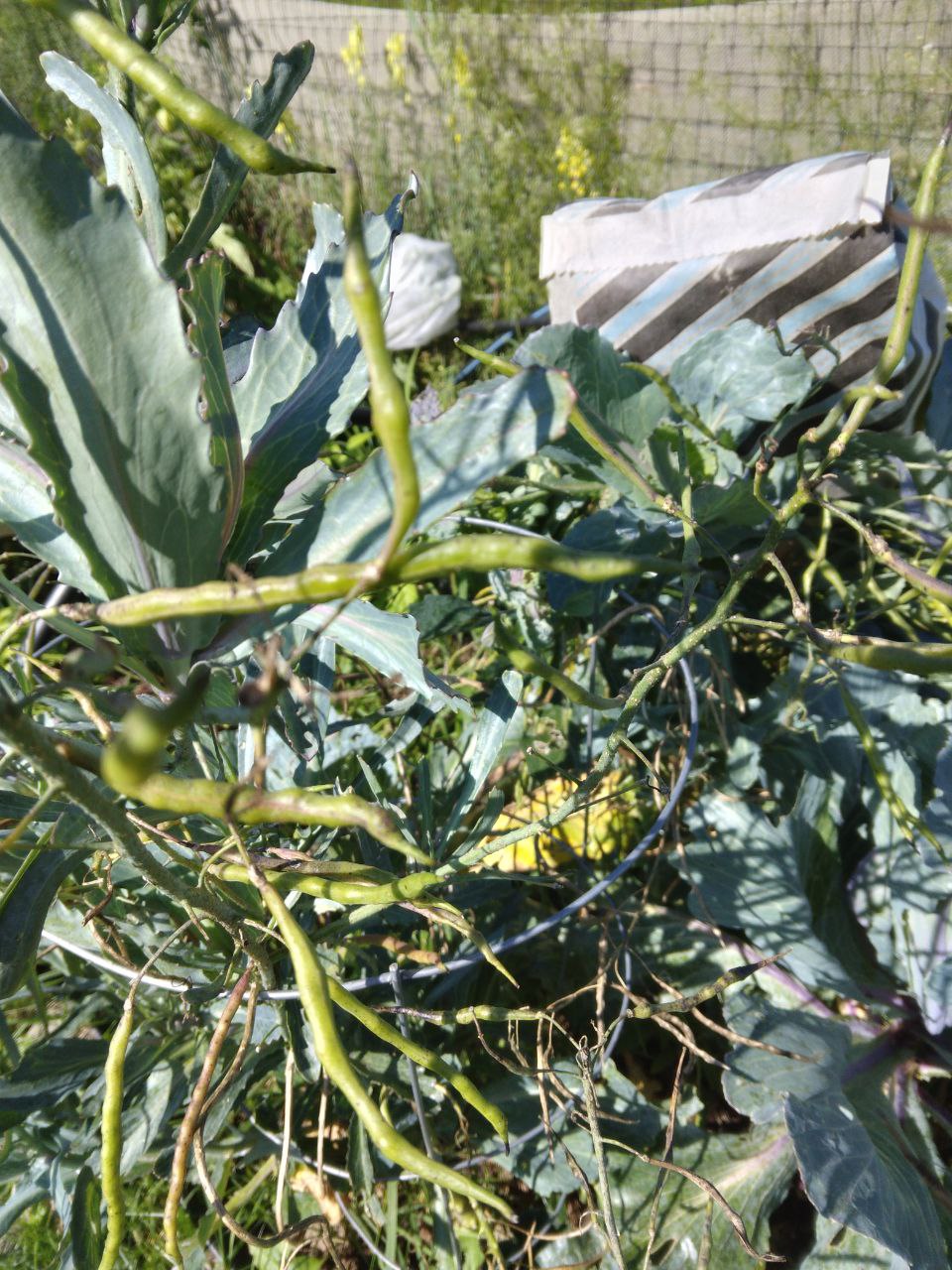 This is January King Cabbage seed pods. Each long bean like pod contains between 5-10 seeds This is January King Cabbage seed pods. Each long bean like pod contains between 5-10 seeds |
My saved seeds
I saved cucumber, melon, beans, and tomato seeds that germinated with good success. I ate one of my cucumbers and it was the sweetest cucumber I have ever tasted! Saving seeds is very special. The seeds adapt to your soil and your garden's climate. It's very magical.
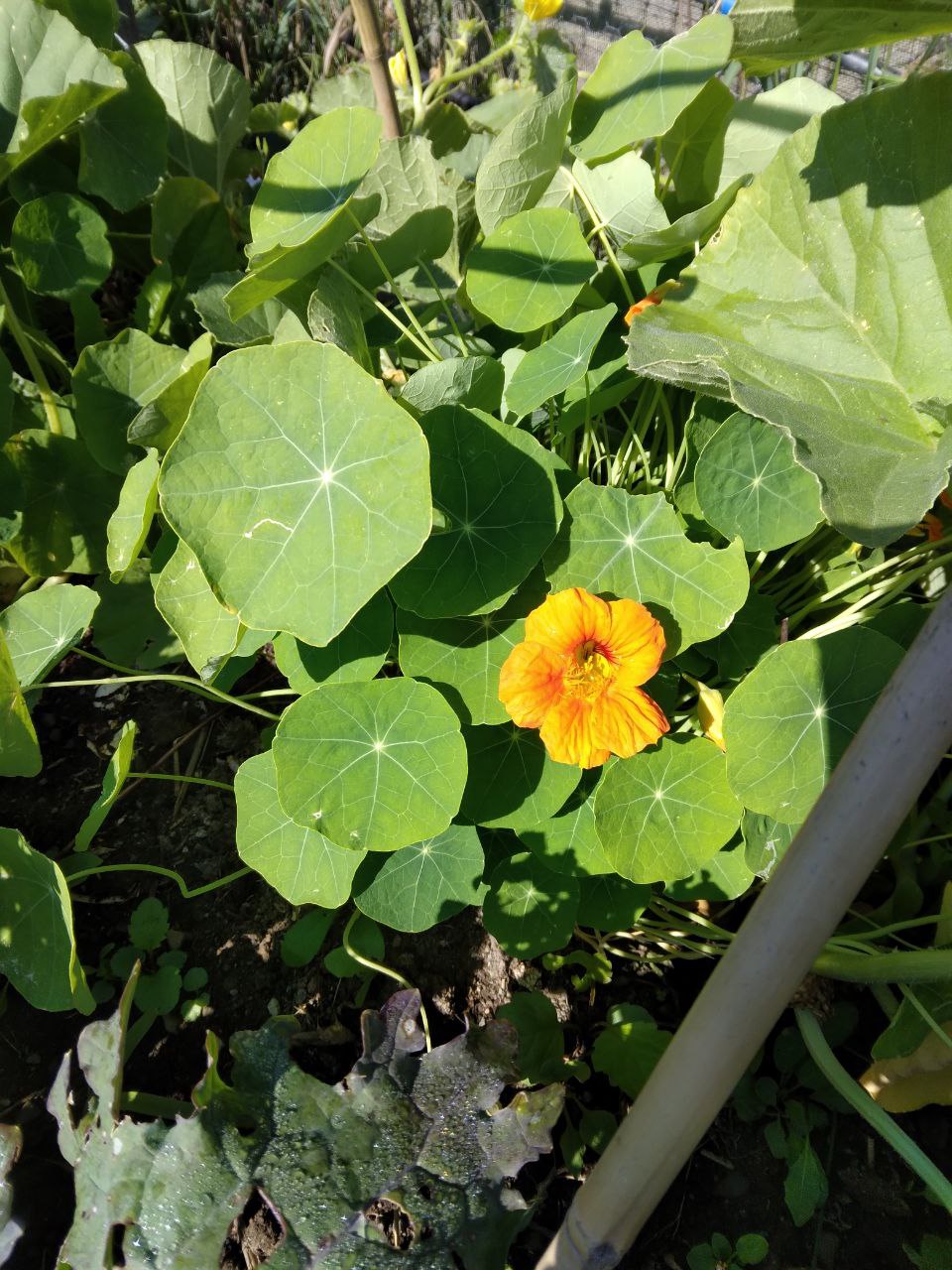 my saved nasturtium seeds my saved nasturtium seeds |
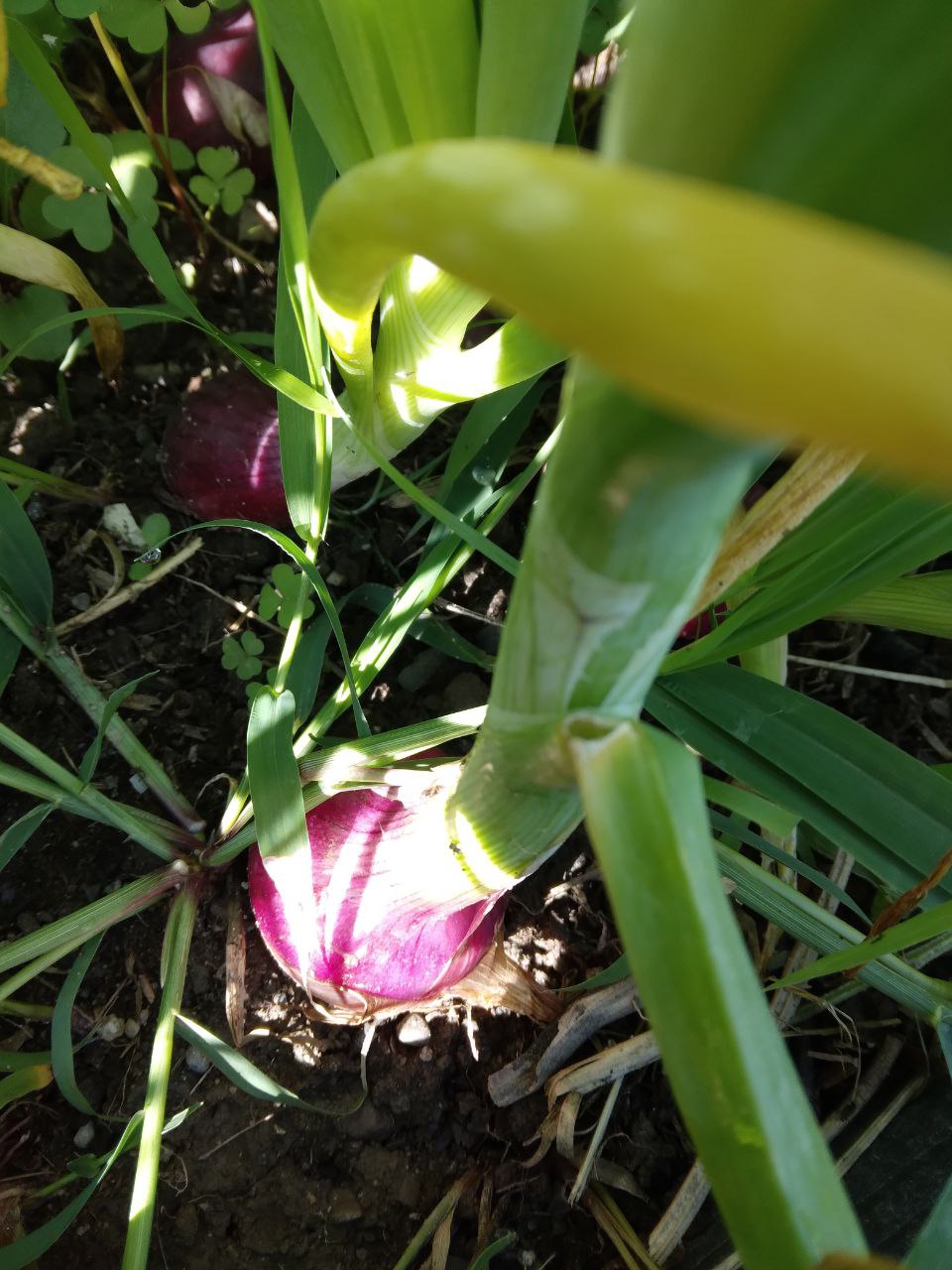 This onion is from my saved seeds. The photo above is an onion seed flower. This onion is from my saved seeds. The photo above is an onion seed flower. |
Micro Greens
One year I tried micro greens under lights in a warm spot in my basement. The light is a little pink in my indoor garden photos because it's the full spectrum seed light.
Below are the broccoli micro-greens that I started in the basement under grow lights and they sprouted in 3 days
In the photo above, I did broccoli micro greens (from the same seed batch I bought 3 years ago) in my sunny living room, giving them natural light and they still sprouted in 3 days.
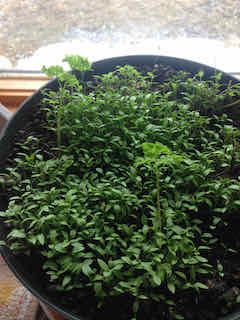 Parsley micro greens in natural light
Parsley micro greens in natural light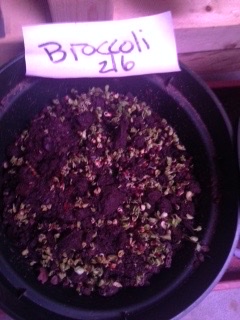 Broccoli micro greens under a grow light
Broccoli micro greens under a grow light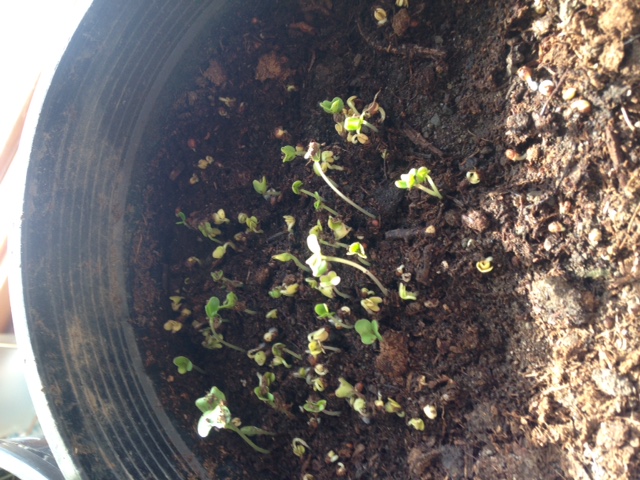 Broccoli micro greens in natural light
Broccoli micro greens in natural lightGarden Map
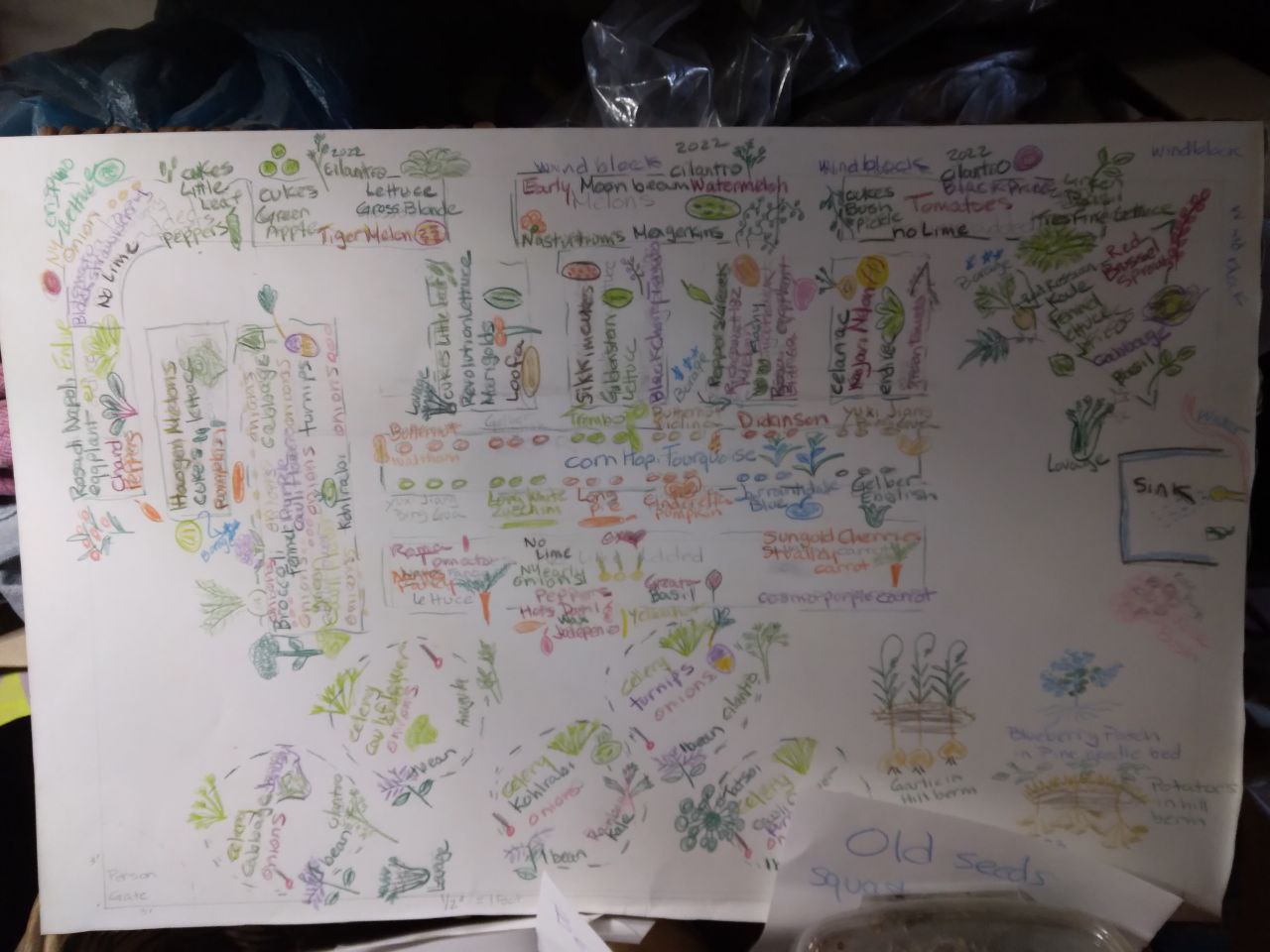 Every year I draw a new garden map to use as a guide, so there's a chance I can fit in all of my plants and seeds
Every year I draw a new garden map to use as a guide, so there's a chance I can fit in all of my plants and seedsI keep Instant Liquid Soap diluted to the Go Soap ratio near my soil mixing station, mounted on a garden fencepost and another one in my garden tool basket. Even though I wear gloves, my hands still get dirty.
Go Soap (aka Waterless Hand Soap) dilute ratio
We have renamed Waterless Hand Soap to Go Soap.
You have an empty Waterless Hand Soap 2 oz. spray bottle and want to refill it. Make a Go Soap refill.
Dilute one bag of Instant Liquid Soap into one quart of liquid soap (32 oz.).
Follow the instructions on the package.
Pour 1/2 of the quart of liquid hand soap (16 oz.) into a one gallon container and fill it SLOWLY with water. This makes 1 gallon of Go Soap, aka waterless hand soap, that you use as hand sanitizer replacement and general cleaner.
Refill an empty spray bottle to use on everything. Click here for more uses
Morning Dew
This is a cabbage and romaine lettuce bed. There are some broccoli's and kales in there too. The lettuce will be ready to pick 2-3 weeks before the cabbage, so I alternated them. While the cabbages grow, if they give a little shade to the lettuce, that's ok. In between, are tiny lettuce and cabbage seedlings so they will grow and replace the ones I pick.
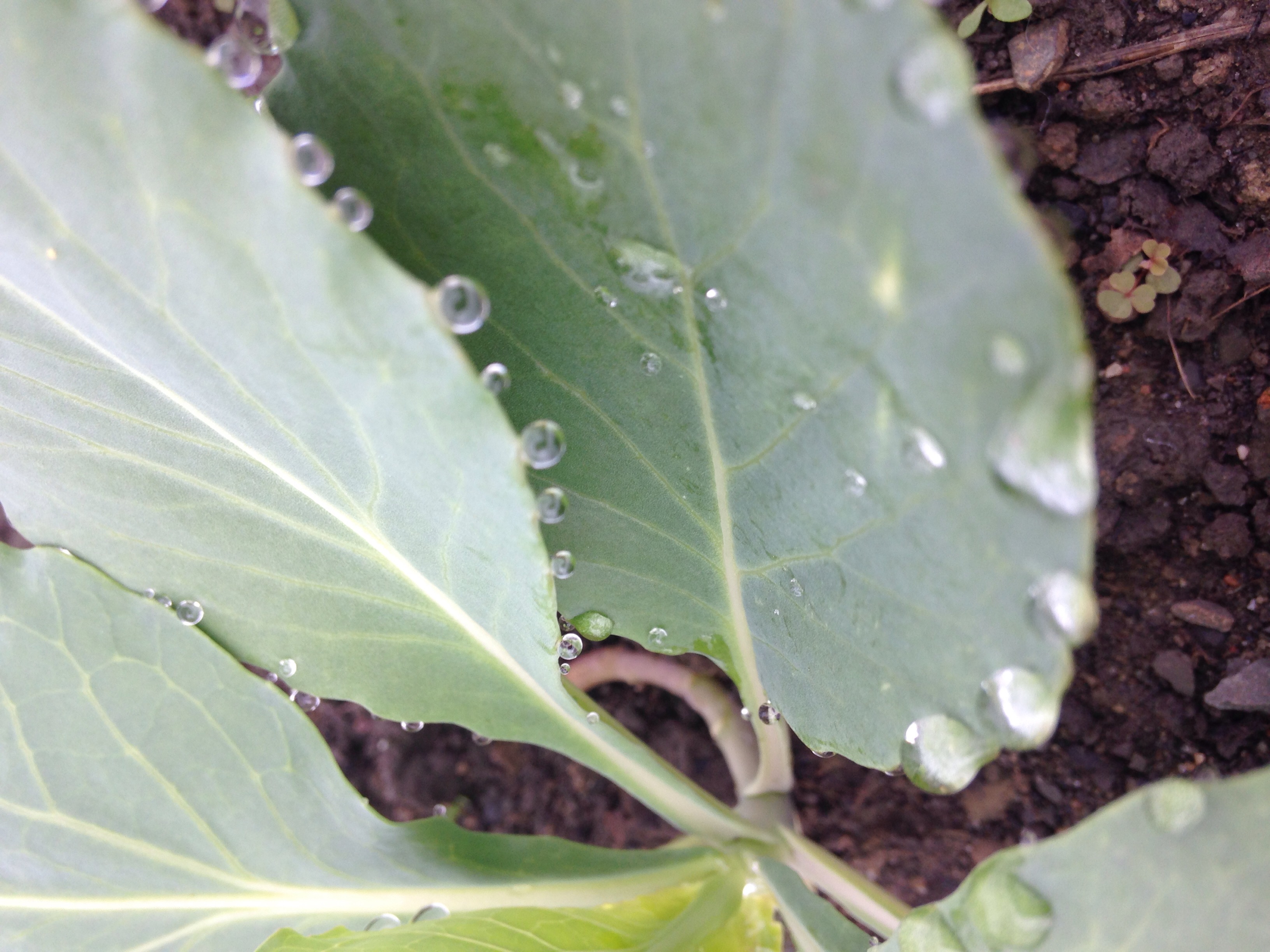 |
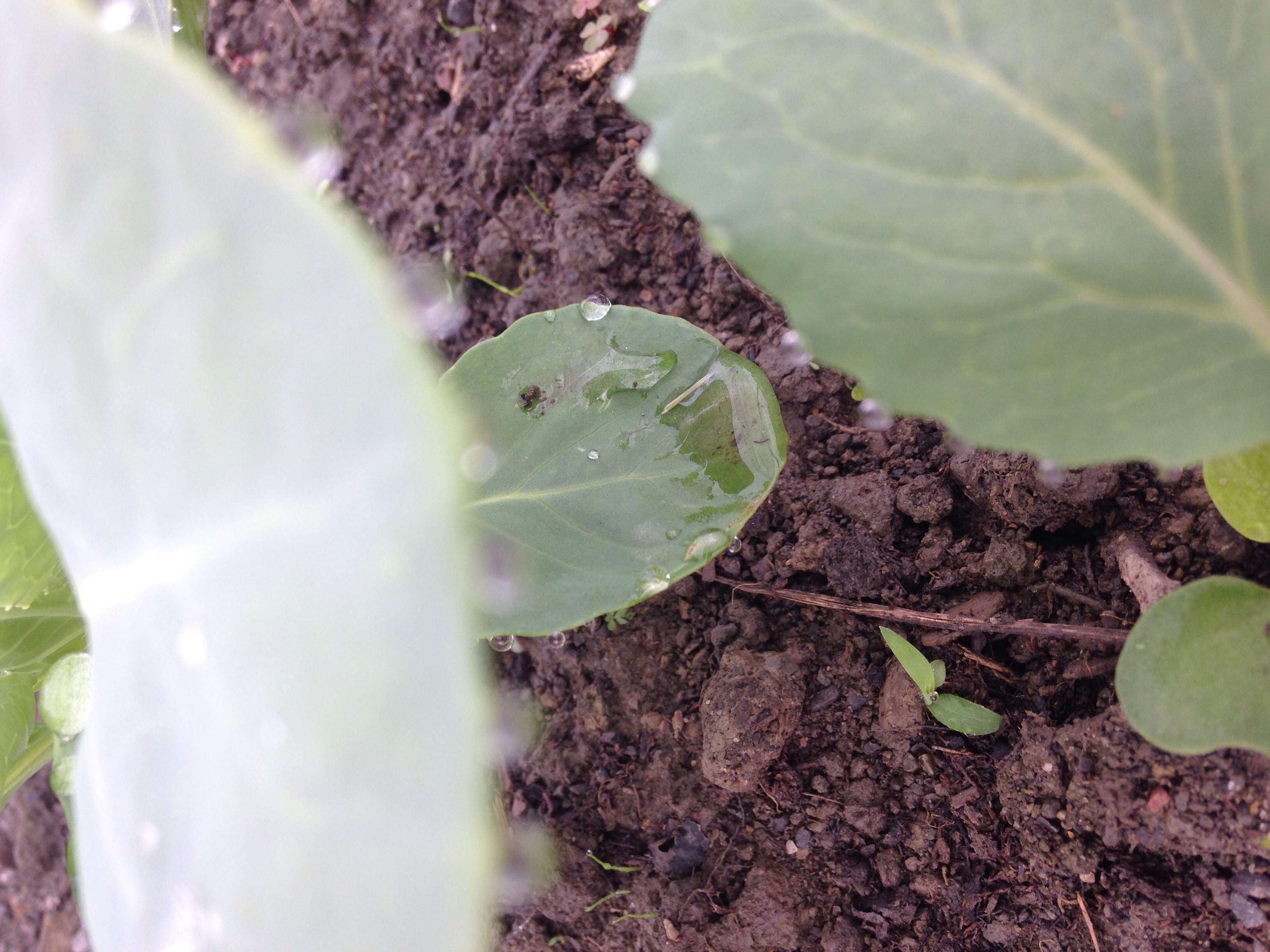 |
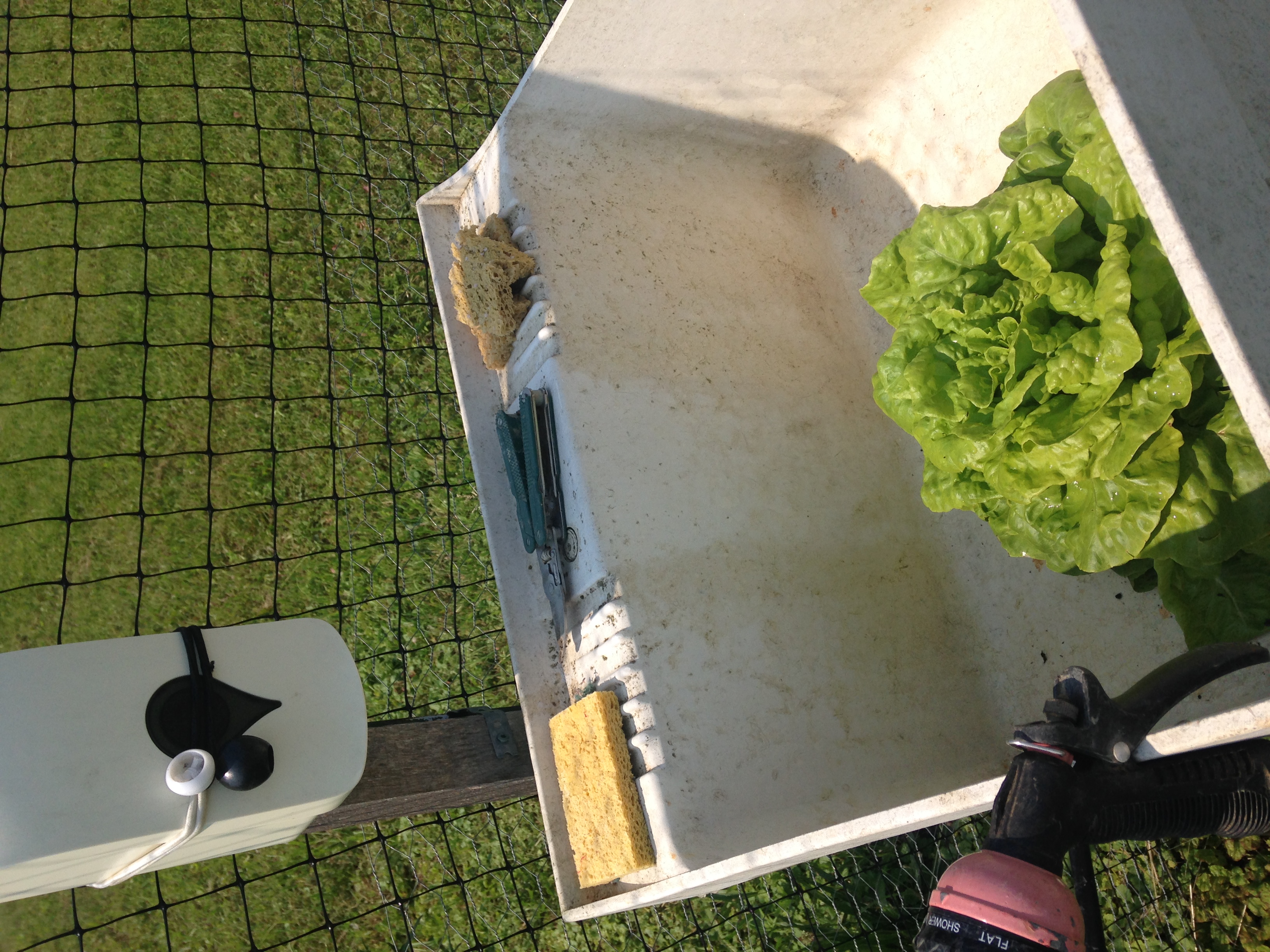
This fiberglass laundry sink is on the south side of the garden. It has removable legs, so I can change its location from year to year, depending on where we rotate plants, and move things around.
I have a soap dispenser mounted on a fence post filled with Liquid Soap Refill for easy hand washing and vegetable rinsing. I'm considering changing that to a recycled plastic bottle that holds more soap. There's a sponge, and a beautiful head of organic Grosse Blonde Paresseuse lettuce. There is nothing like picking a head of lettuce and washing off the mud splatter outside before bringing it in the kitchen for lunch. This is as fresh as it gets, retaining as much nutrition as possible. It's an energizing gift of the universe.
Ithaca Bar Soaps are a cold process bar soap formulation, that remains solid throughout its use. For a longer life, keep in a dry place between washings. If a bar of soap sits in a puddle, it will shorten its lifespan, but will not turn to a liquid. If you attempt to melt Ithaca Soap Bars, they will re-harden eventually.
Ithaca Soap's Instant Liquid Soap is a completely different formulation. This patented soap formulation is not meant to be used as bar soap. Its solid appearance will immediately begin to turn into liquid soap, when it comes in contact with water, diluting it into our same Ithaca Soap Liquid Soap.
Happy gardening
- Home
- Liquid Hand Soap Refill
- Garden
 Choose from 5 different natural essential oil scents
Choose from 5 different natural essential oil scentsInstant Liquid Soap is the perfect stovetop cleaner. It's gentle on your hands while being tough on built up, caked on grease. Click here to read How to Clean your Greasy Stovetop using zero waste natural soap methods
- Tear open pouch at notch
- Fill pouch with water to top of label. Gently stir.
- Pour into a reused plastic bottle. Use.
The future starts now as you end single use plastic bottles. Click here
Sign me up now
for a 25% off coupon
ithacasoap.com
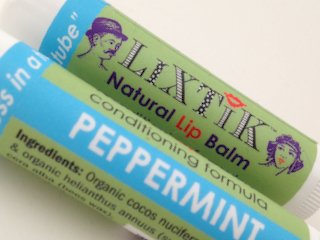 Peppermint bees wax lip balm
Peppermint bees wax lip balmMoisturize, hydrate, and nourish your lips with wonderfully luxurious
Leave your lips moist and smooth for many hours. Soothes severely chapped lips.
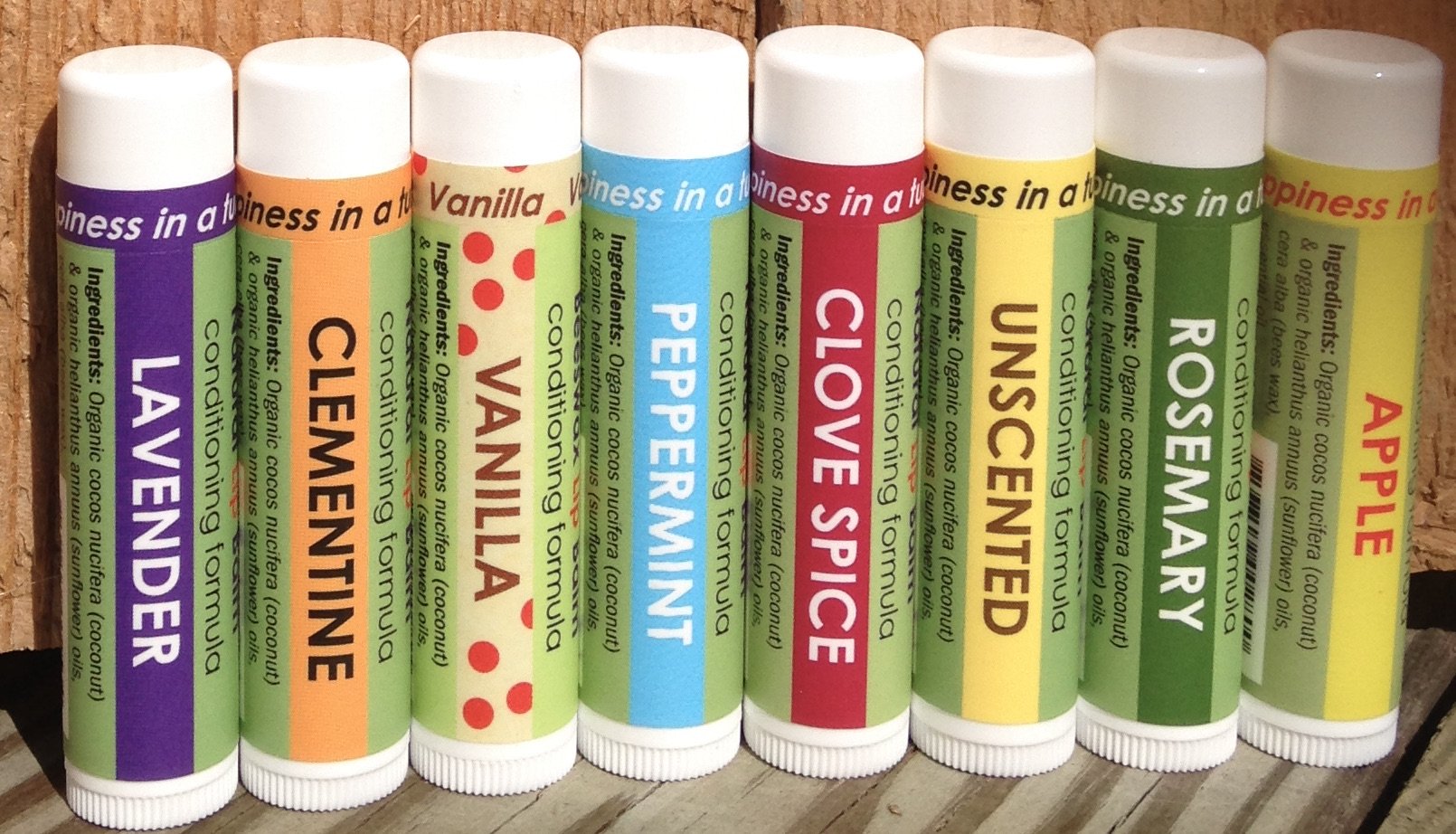 Choose from 8 LiXTiK Beeswax flavors/scents. Ingredients: Organic coconut and sunflower oils, premium beeswax, 100% pure essential oils Choose from 8 LiXTiK Beeswax flavors/scents. Ingredients: Organic coconut and sunflower oils, premium beeswax, 100% pure essential oils |
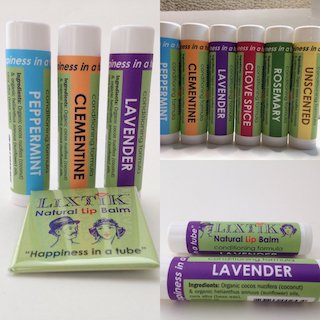 Get a 3 pack and save Get a 3 pack and save |
Have A Great Story About This Topic?
Do you have a great story about planting your garden? From starting seeds and drawing your garden map to buying plants starts at your farmers market and filling up your garden beds, Share it!
